News from Reserva Don Luis
The reserve is a beautiful place to live and work, and we count ourselves very lucky that we're able enjoy every minute of both. Every day is crammed with challenges, but the reward that lies in seeing these animals prosper more than pays for every blister and sore back. These snippets give you an idea of what it's like to be here.
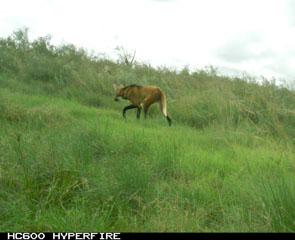
Maned Wolf captured on Camera Trap
Friday, March 29, 2024
We now have several images of the Maned Wolf at our reserve on various camera traps, though all in the south. It is classed as 'Near Threatened' in the IUCN redlist, but is difficult to see due to its nocturnal habits. We believe that there are more than one of these Canids at the reserve.
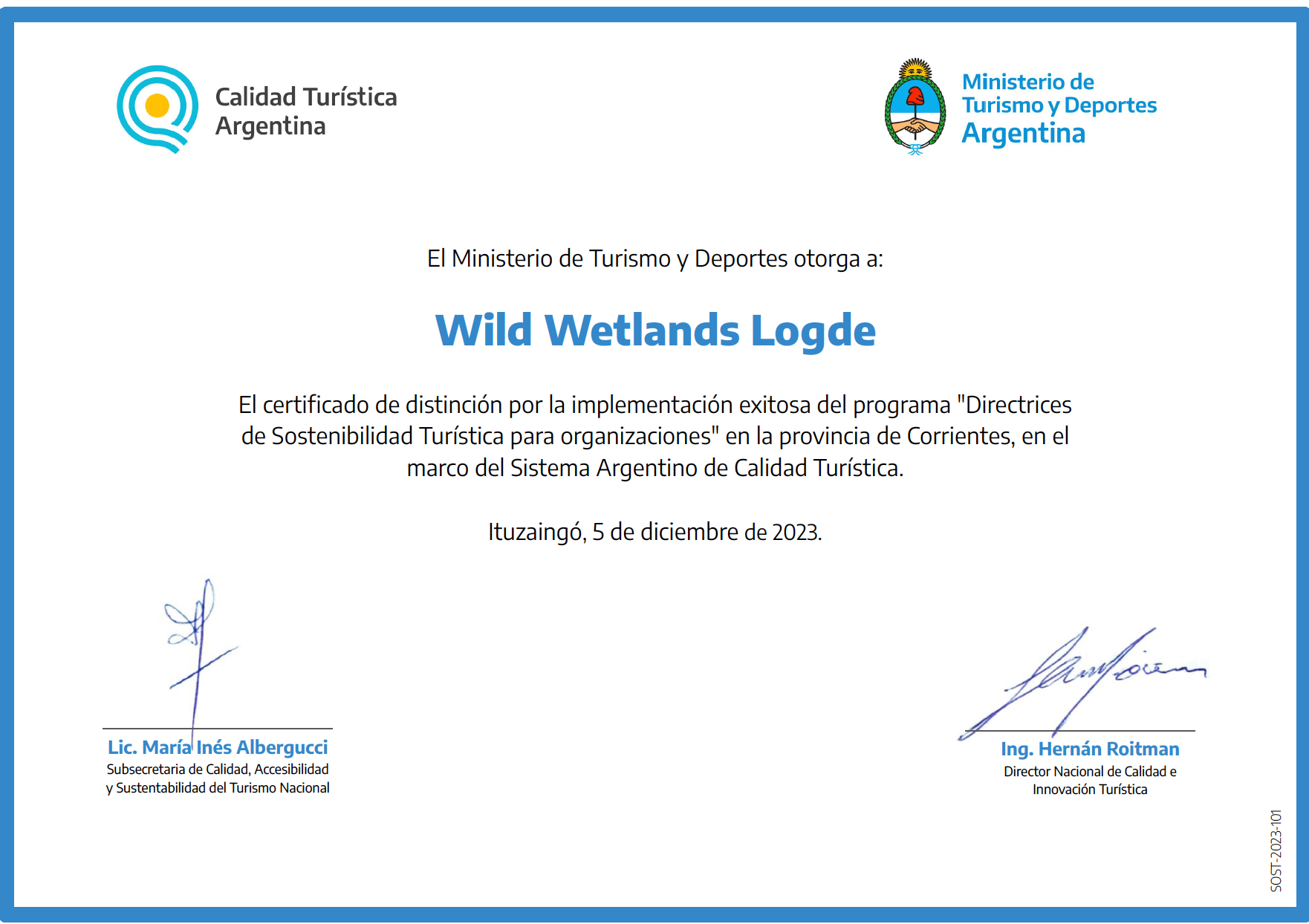
Sustainability Certificate for Wild Wetlands
Wednesday, December 6, 2023
Our Wild Wetlands resort has gained a certificate from the Ministry of Tourism in Argentina, for being sustainable.
Some of our eco incentives include power that is totally solar and windmill, our own organic vegetable garden, Biodigester waste disposal system, no single use plastics, reforestation, composting, re-cycling, amongst others.
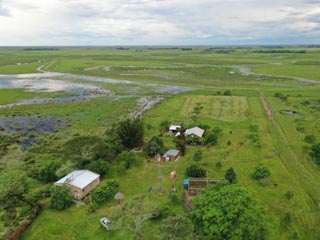
Heavy rains for Reserve
Wednesday, December 6, 2023
During the past couple of months, the rains have been heavy and persistent. We are all happy that we are very much a wetland again, not least because this will help prevent the neighbours cattle from getting in to our land. As a result, we are unable to even start the 2km of fence repair in the north, although we have managed to buy the posts and wire. Our access road is often impassable, so our team go out after heavy rains with the tractor, and carry large trunks of dead trees to cover the gaping holes in the road.
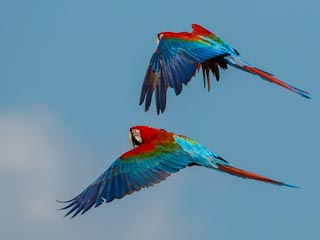
Macaws project at Reserve Don Luis
Sunday, November 26, 2023
The Rewilding project for the Green-winged Macaw is now based at Reserva Don Luis. In the winter, a large aviary was installed in our woodland, Monte Nacurutu. The 5 Macaws were placed inside it for a period of quarantine, then released into our reserve. They have supplementary feeds so are not yet completely independent, and as a result can be seen around the woodland at feeding times. The Macaws are not new to our reserve, as we have a lot of native fruit, but we are happy to see them based with us. They were previously in the National Park, Cambyreta, but due to various pressures eg fires, drought and hunters, the team, led by Mane Massat, decided to move the project to our reserve. Photo by Sebastian Navajas
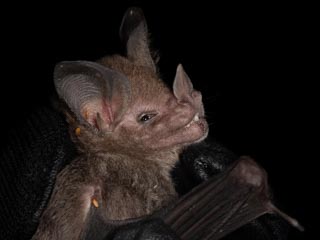
Another New Bat Species for Team
Thursday, October 12, 2023
We managed to capture this very rare bat, that is only present in Misiones and Yuyuy, at Parque Provincial Mocona in Misiones. Tonatia bidens is a member of the family Phyllostomidae, (sub family Phyllostominae). It has only been captured once before in this century.
It is like a miniature Chrotopterus auritus and whilst not totally carniverous, it consumes insects, occasionally fruit and probably bird eggs and chicks. Very little is known about this species.
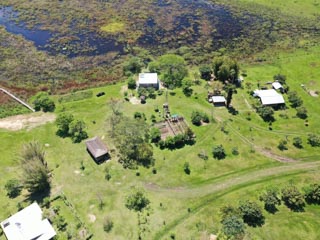
Reserva Don Luis a wetland once again
Friday, September 29, 2023
Great to see our lovely reserve is once again a wetland. We have had around 450mm of rain during the past month and what a difference it has made. May it continue!
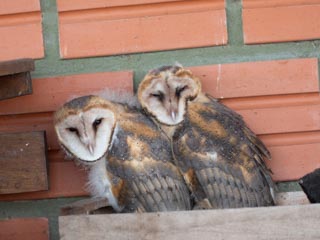
Barn Owls using firewood box
Friday, September 29, 2023
We discovered these 2 beautiful recently fledged Barn Owl chicks using a box of firewood placed outside our first build Lodge - Tito alba.
Up until recently they have been using the beautiful owl box that was designed and built by Cepi Oporto, one of our trustees.
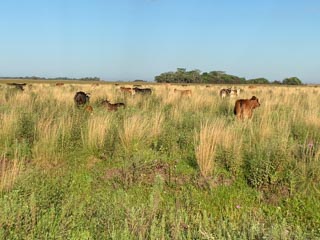
Invading Cattle
Saturday, June 3, 2023
For the past 4 months we have had large invasions of our neighbours cows in our pristine land, tampling down our native species' habitat and coming into our garden.
Evidence of our neighbour's cattle invading our reserve. At times we have more than 100 cattle from various neighbours.
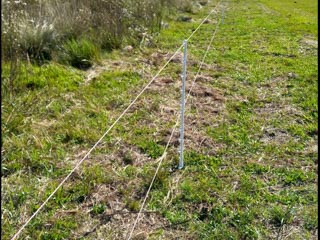
Neighbour's Cows Invade Reserve
Saturday, June 3, 2023
We have had to take expensive emergency measures and have invested in 1.5km of electric fencing which is proving successful at keeping the cattle out of the garden and around the houses at least. In the north we are committed to replacing 2km of destroyed fencing (partly by the wildfires last year). This is all costing us a lot of money and we are having to compromise on various projects to channel our funding toward just keeping our neighbour's cattle out.
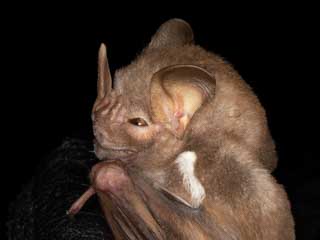
NEW Bat species for Reserva Don Luis
Wednesday, April 5, 2023
We were delighted to capture this unusual looking, rare bat in one of our nets at the reserve on 30/03/2023. This is the first time we have seen this bat here and believe that it is the first ever captured in Esteros del Ibera.
Pygoderma bilabiatum is usually only found in Misiones, Salta & Jujuy although it has been found in Corrientes, near the border with Misiones.This is quite a large extension of its range. The bat was released unharmed after weighing & measuring.
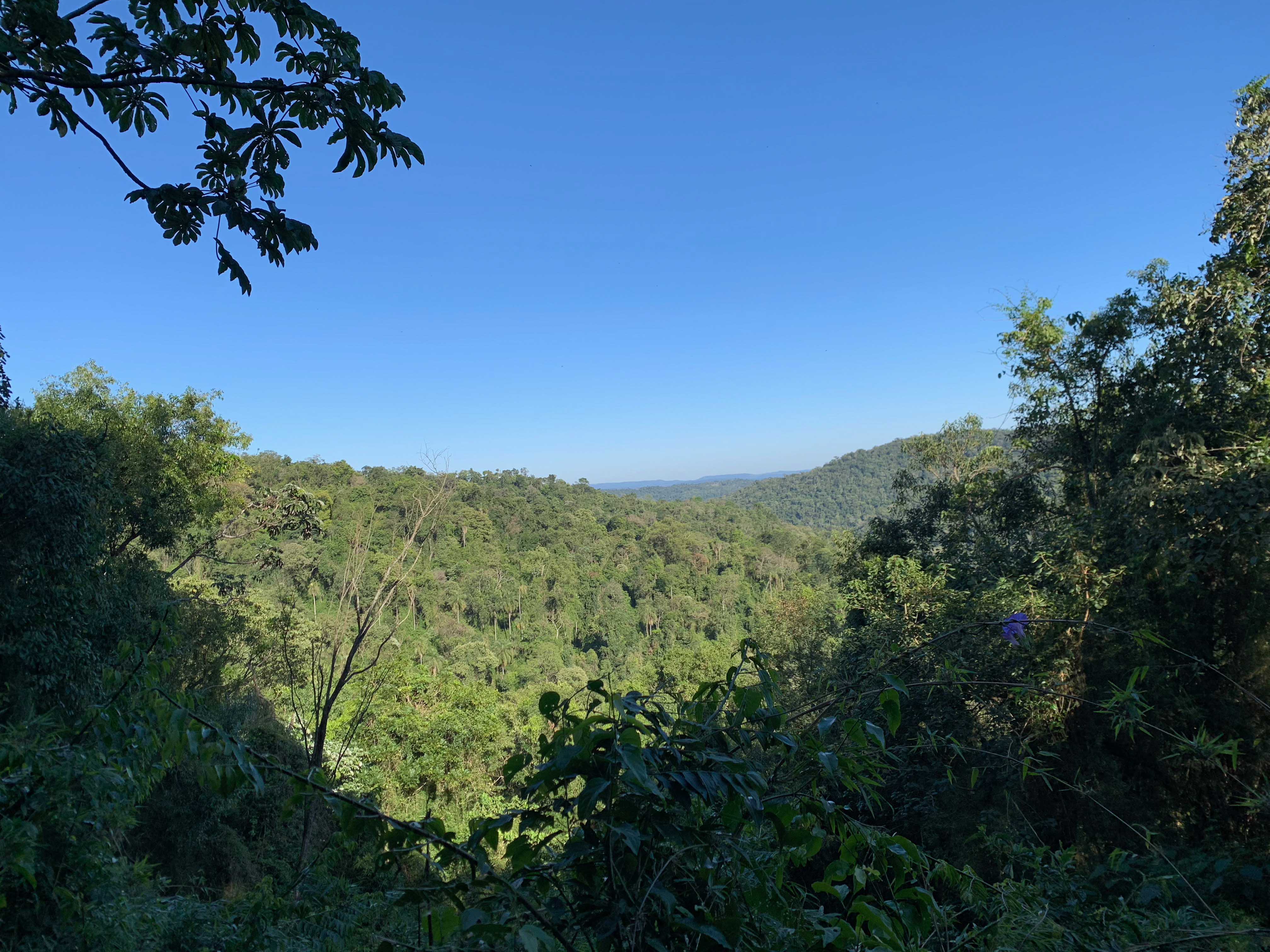
Trust buys land in Misiones
Tuesday, December 20, 2022
We have just completed the purchase of 100 hectares of prime native woodland near San Pedro in Misiones.We intend to keep the land as it is and only form a path down to the stream at the southern end of the land, where we may build a platform for birding. We also plan to do bat research in due course.
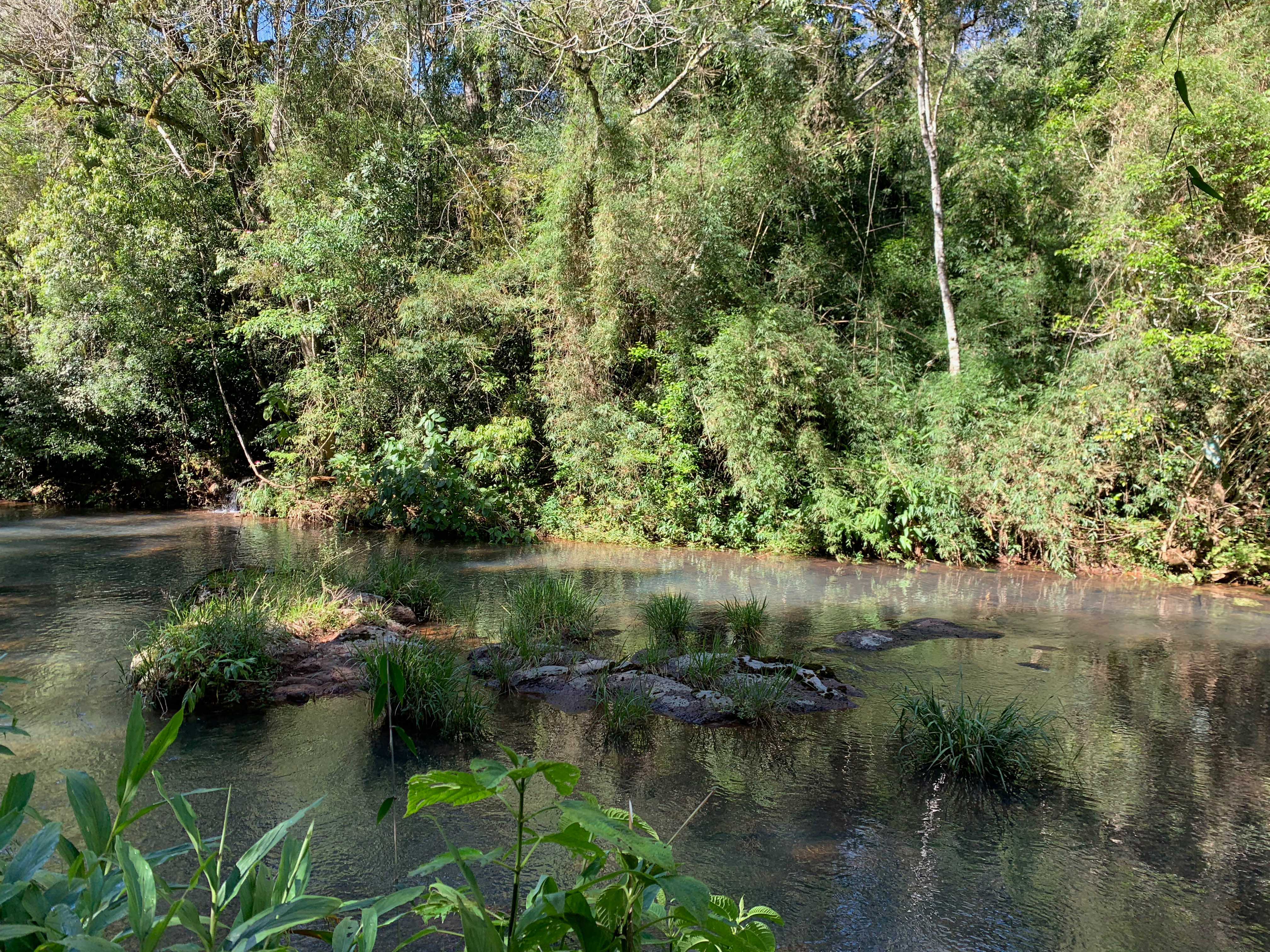
Photo of the stream at new land in Misiones
Tuesday, December 20, 2022
Here is another photo of our new conservatiion land near San Pedro in Misiones. The highest part of the land is 530m asl.
This is the stream at the southern end of the lot.
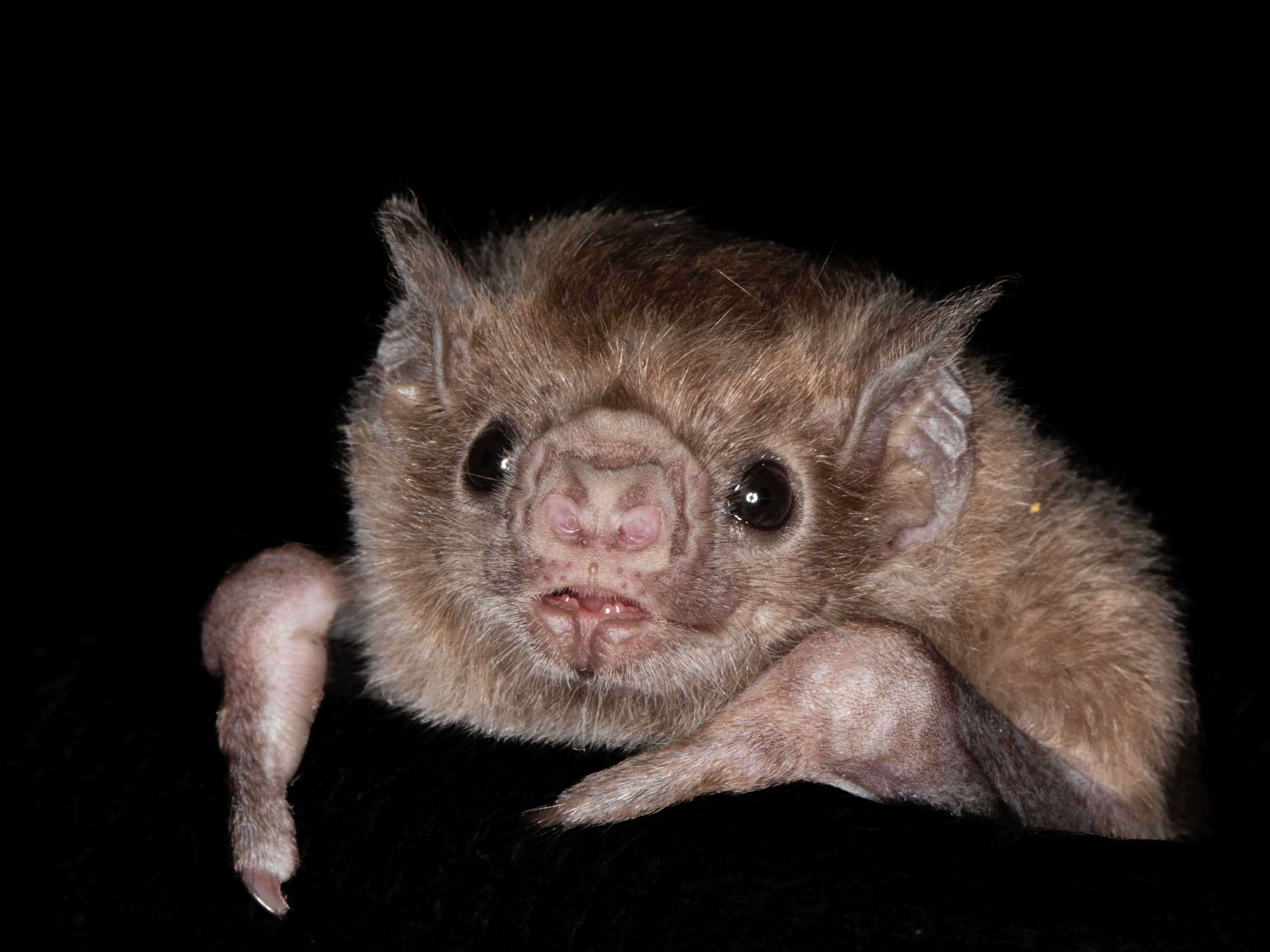
New bat species for bat team
Monday, December 19, 2022
We discovered this beautiful Diaemus youngii in the north of Misiones province during the past few days. Its common name is White-winged Vampire bat and it is rare.
It looks similar to the ubiquitous Common Vampire Bat, Desmodus rotundus, but has suble differerences, including white wing tips and edging.
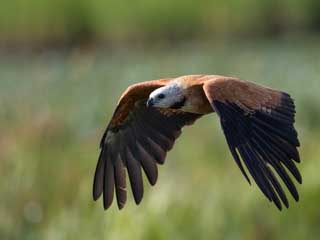
Lots of birds at Reserve
Friday, October 14, 2022
We are delighted to find Reserva Don Luis teeming with birds, some of which we have not seen before or not for many years. In spite of the awful fires in February, the birds are definitely back. This is Aguilucho Pampa or Black-collared Hawk which we are seeing in the south of the reserve and which is probably breeding.
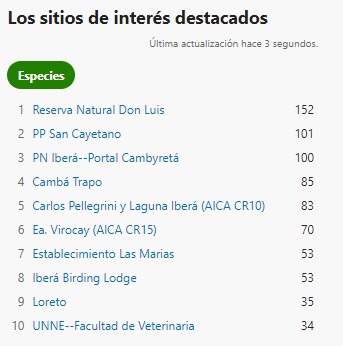
Great Global Birding weekend
Friday, October 14, 2022
We took part in the Global birding weekend bird count for EBird on Saturday 8 Oct. This is a worldwide count of species taking place over a 24 hour period. Our team at Reserva Don Luis managed to count 152 different species and we were top team in our province of Corrientes, 3rd best count in Argentina. Congratulations to all the team.
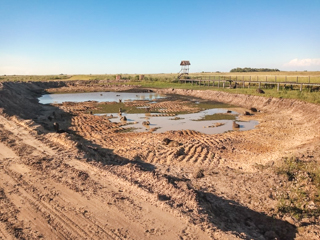
Deepening of Laguna
Saturday, January 8, 2022
We are in our second year of severe drought, which is very sad for our native wildlife, survival of the fish, our Caymans. We had to take a drastic decision to bring in a mechanical digger to deepen our laguna to enable our wildlife to survive. Last year we sunk another borehole, deeper than the original one, and from this will have a good supply of water with which to fill this currently empty space.
It may look barren at the moment, but it is a lifeline for our wildlife and will start to look good again within a year.
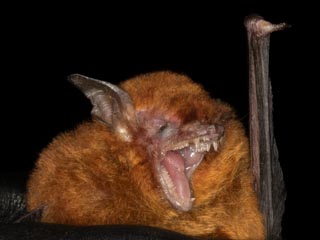
Another new bat species for team
Saturday, January 8, 2022
As our research continues year after year, obviously it is more difficult to come across new species. We were therefore delighted to capture this brilliant red Myotis ruber during a research trip to Misiones. This Myotis is larger than the other occurring Myotis in Argentina. It weighed 10 grams and had a forearm length of 41.3mm. It was released unharmed, as usual, and we recorded its echolocation on release.
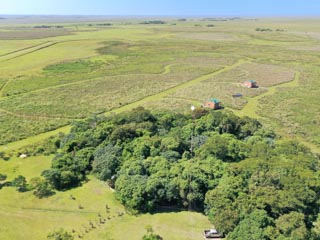
Wild Wetlands resort
Saturday, January 8, 2022
Here is a drone shot taken just before Christmas 2021 showing Wild Wetlands Lodges.
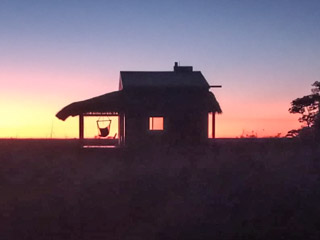
2 Lodges at Wild Wetlands
Thursday, June 17, 2021
We have completed both Lodges at our Wild Wetlands resort in the very biodiverse Esteros del Ibera, Argentina. They are beautifully appointed, with thatched gallerias, totally powered by a brand new solar system and ideal for birdwatchers and naturalists. When Argentina is finally out of lockdown, we hope to welcome visitors from Europe and worldwide.
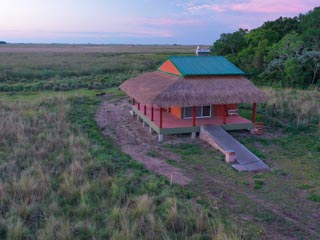
New Lodge for naturalists
Saturday, December 5, 2020
We have completed our first Lodge at Reserva Don Luis. This has been specially designed for naturalists who wish to go to sleep and wake up amongst nature without any light pollution, noise polllution or fossil fuels. Our lodge is powered by a state of the art solar system and innovative drainage system. The spacious lodge can sleep up to 3 people in perfect comfort and is an ideal base for bird watching with 3 different habitats in close proximity. We are now starting our second lodge and hope to be operational in March 2021.
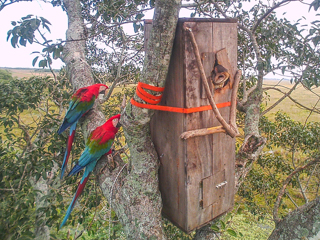
Barn Owls in Macaw box
Thursday, May 7, 2020
This amazing picture was taken by one of our cheaper camera traps. The box was installed by the volunteers from the Green-winged Macaw rewilding program several months ago. A pair of Barn Owls has taken up residence there and you can see the 2 Macaws eyeing up the box only to find that they had been beaten to it by the owls. We now have evidence that the owls have laid 5 eggs and 2 have now hatched.
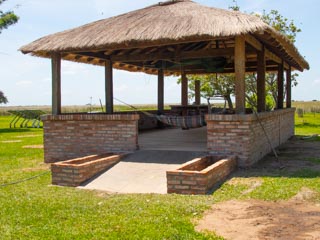
New Siestera for reserve
Friday, December 20, 2019
We are more than three quarters through completing our new 'Siestera'. The original idea was a for a large room open on all sides but protected against mosquitoes, in order to relax during the hot hours of siesta time. Cepi has started to create a beautiful rustic bar and the floor is ideal for dancing, so there may well be other uses for this structure.
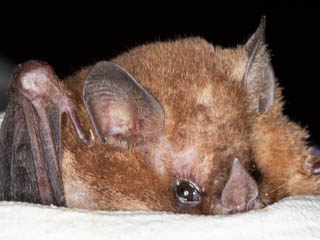
New Bat Species for Corrientes
Tuesday, November 12, 2019
During a training/demonstration session at Isla Apipe in October we managed to capture a nectivorous species in our net. This is the first report of Glossophaga soricina in Corrientes. This individual flew into our net in the garden of the Ecolodge La Casona. This is exciting news.
This species feeds from the nectar of flowers that open at night such as some cacti and can hover much like a humming bird.
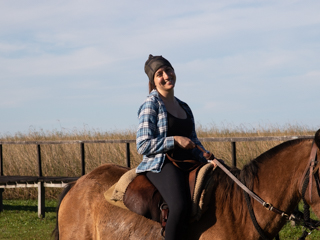
Volunteer Melisa
Monday, October 21, 2019
Our latest volunteer, Melisa, has shown great enthusiasm for bat research and has been invaluable in categorising our bat guano using the microscope.
She helped us with our bat research in Misiones, Bahia Caraya and Isla Apipe Grande as well as our research at the reserve.
We hope that she has learnt a lot about our bats of Corrientes and Misiones.
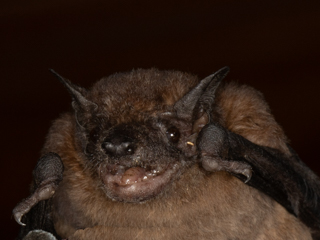
New bat species for team
Monday, October 21, 2019
A new species for the bat team. We captured this small dark bat, Molossops neglectus, in the north of Misiones, at the private reserve of Fundacion Vida de la Silvestre Urugua-i. It is classed as rare in Argentina and there have only been a handful of registrations of this species.
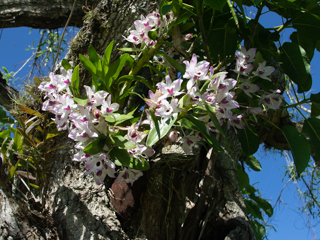
Native Orchids at the reserve
Sunday, October 20, 2019
Our orchids have been spectacular this year thanks to Cepi. Although they did not appear naturally, they are surviving happily in this tree and should flower for many years to come.
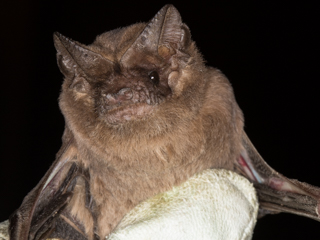
New Species for Reserve
Friday, October 4, 2019
We did a training session on Saturday and put out a double high net to see what we could catch. To our surprise the first bat turned out to be Tadarida brasiliensis, Brasilian Free-tailed Bat. These are very rare in Corrientes, although common throughout most of Argentina and this is a first for Reserva Don Luis. This makes a total of 14 bat species captured at the reserve.
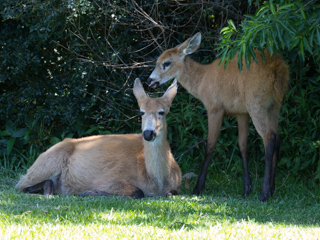
Rosita missing
Thursday, August 29, 2019
We have not seen Rosita, our semi tame Marsh Deer since early June and we are all very worried.
She is a totally wild animal and sometimes disappears for several weeks but never for this length of time. We are also concerned about her latest offspring - Valentin.
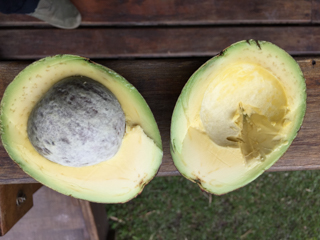
Our own Avocados
Tuesday, June 4, 2019
We only had 2 fruit on one of our 8 Avacado trees but were they delicious! We first planted Avacados 9 years ago and have been waiting for them to bear fruit. It was worth the wait! We are expecting a lot more fruit for next year's crop.
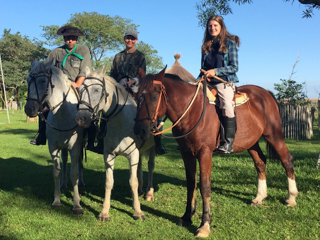
Molly, volunteer for March/April
Friday, April 19, 2019
We were pleased to welcome Molly as our volunteer for March/April. Molly has experience of bat echolocation and has been very useful for our bat projects. She accompanied us to the private Reserva Urugua-i and was a useful member of the team. Here she is with Mario & Miranda on horseback. Molly was wonderful with the horses, all of whom will miss her a lot.
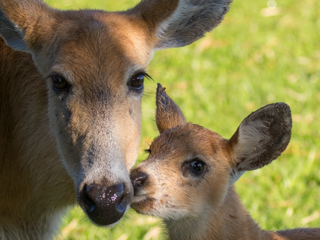
Rosita with Valentin
Thursday, April 18, 2019
Rosita is bringing her new baby into the garden at Reserva Don Luis quite often. This is always a joy to see. Here he is around 5 weeks old and is already nibbling grass. He was born on 14 Feb, hence the name Valentin.
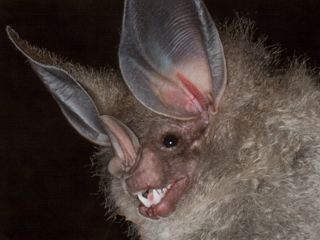
New Species for Bat Team
Saturday, April 13, 2019
We captured two of these large bats at the private reserve belonging to Fundacion de la Vida Silvestre in Urugua-i, Misiones. They are powerful bats and have a diet that includes birds, reptiles, amphibians and other bats. They are classed as Carnivorous and are the largest bat species in Argentina (2nd largest in South America). They weigh around 85g and have a forearm measurement of around 85mm. They are only found in the heart of the Selva and this reserve was definitely very remote. We had a very successful 3 days there.
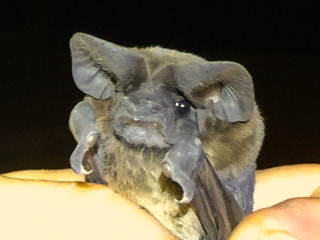
Another new bat species for the Bat Team
Monday, March 4, 2019
We captured this beautiful medium sized Molosside in Misiones in Feb 2019. It is Nyctinomops laticaudatus. This is quite a rare species and although similar to the more common Tadarida brasiliensis, it has some notable differences. It is insectivorous and has a distinct echolocation call. Thanks to Temaiken for allowing us to use their Reserva Osununu.
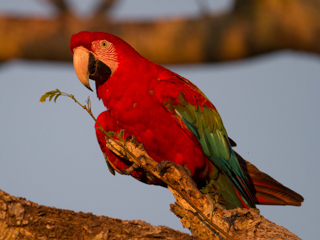
Green-winged Macaw in garden
Monday, March 4, 2019
We are always delighted to see these colourful noisy birds visiting our garden. This one stayed for around 15 mins and amused us all with its antics. These birds are part of a rewilding project run by CLT.
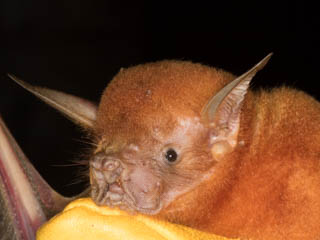
Bat team capture 2 new species of bat
Sunday, December 16, 2018
The bat team did some research on bats on the banks of the River Parana in a place called Puerto Rzpecki last week.
We managed to capture 2 new species for the team. Noctilio albiventris and its larger cousin (see photo) Noctilio leporinus.
These are both large bats that hunt over the surface of the water, leporinus catching small fish. Both species are brightly coloured and have large feet and claws with which to catch their prey. They both have a dorsal stripe.
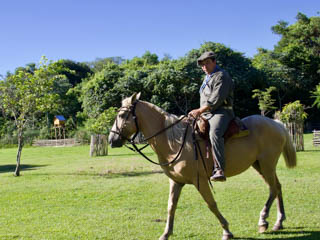
New horse for the reserve
Thursday, December 13, 2018
We have recently purchased this pretty Palamino mare for Mario to ride as some of the other horses are a bit old to be ridden.
We are calling her 'Duraznos con Crema' or in english 'Peaches & Cream'
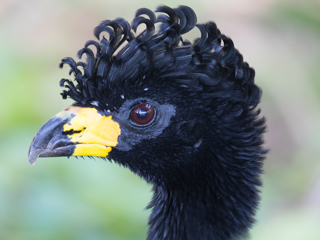
Tito our Crax fasciolata
Monday, December 3, 2018
We are sad to announce the death from natural causes of our Bare-faced Curassow who we fondly referred to as 'Tito'. He was around 30 years of age and we were honoured to look after him for the past 3 years 7 months. He will be sadly missed.
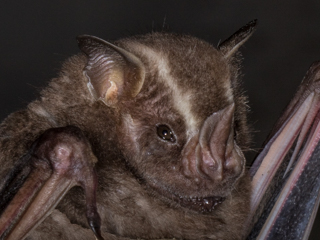
Artibeus lituratus in Corrientes
Tuesday, November 6, 2018
Finally we have captured Artibeus lituratus in Corrientes. We came across this example feeding from the fruit of a Ubujay tree in Isla Apipe, an island in the River Parana off the coast of Ituzaingo. All bats released unharmed and research is under the authorisation of Recurses Naturales.
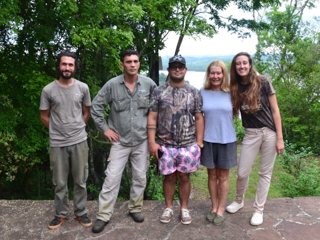
Bat team in Reserva Osununu
Tuesday, October 23, 2018
The current Collett Trust bat team went to the private Reserva Osununu in early October for bat research. We had a very successful 3 nights. From left Martin, Raul (guardeparque), Martin, Miranda, Antonella. We plan to return in early December when there is more native fruit around.
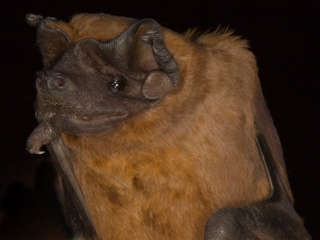
Molossus rufus
Tuesday, October 2, 2018
We are catching more Molossus rufus at the reserve than before. Maybe due to the fact that our neighbour that lives 20km to the north destroyed his roost of this beautiful species and they are coming down to us. This species can vary a lot in colour and this one was a beautiful reddish colour.
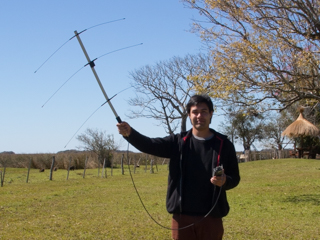
New volunteer
Monday, September 10, 2018
This is our new volunteer, Gustavo, who will be at Reserva Don Luis until early October. Here he is practicing radio tracking.
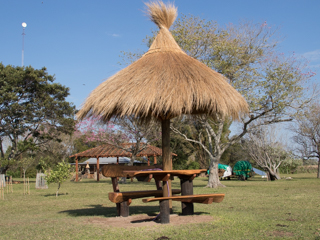
New Quinchito at Don Luis
Sunday, August 19, 2018
During the winter we have cut a lot of Paja Roja which is the grass used for thatching. Here we have used it to make a charming place to sit and watch birds. Thanks to Cepi for designing and building the table and bench.
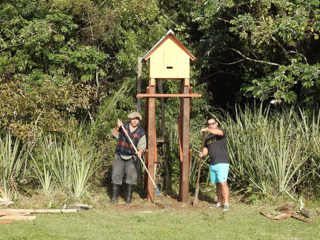
Bat Condo up and running
Saturday, June 23, 2018
The Bat Condo is now erected at Reserva Don Luis.
It is currently winter and there are less bats around but we expect some occupations in the spring. It measures 1.2m x 1.2m and we have put it in a sheltered area where it will get the morning sun but only partial afternoon sun.
We are keeping our fingers crossed!
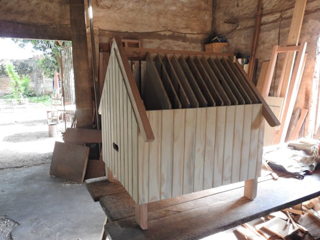
Bat Condo for Don Luis
Wednesday, June 13, 2018
We have adapted a design from USA for a Bat Condo which can house up to 3000 bats. Our design includes roosts for small and larger bats in 4 different sections. Ideally we would provide roosts for 4 different species. It has been made by a local carpenter who has done a super job and will be in place at our reserve in a couple of weeks. We will keep you advised if and when we get some occupations.
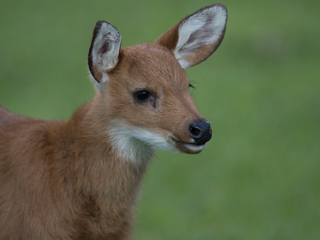
Rosita's new Faun
Saturday, May 26, 2018
We have named Rosita's latest offspring Camby which is a Guarani name for milk and forms part of the name of our region in the Ibera Marshes. We will find out the sex in due course but he/she appears to be quite calm. Birth date was 01/05/2018
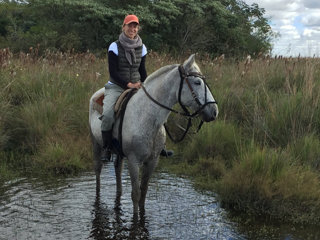
Beatriz, our volunteer May-June
Saturday, May 26, 2018
This is Beatriz, our volunteer for May & June. She is doing a study of our Howler Monkeys and taking care of the camera traps during her stay. The weather has been a bit cold for bat research but we hope to get the nets out tonight.
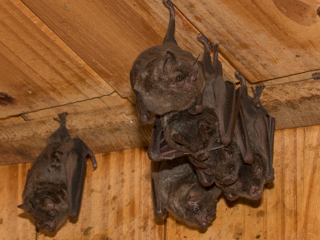
New bat species for Bat team
Saturday, May 26, 2018
We were invited to a private Lodge in the heart of the selva in Misiones. Whilst out birding we came across an abandoned house and outbuildings. Inside were 3 species of bat, including Carollia perspicillata (photo), Desmodus rotundus and Platyrrhinus lineatus. This is the first time that we have come across Carollia in Argentina although I have seen it in other countries.
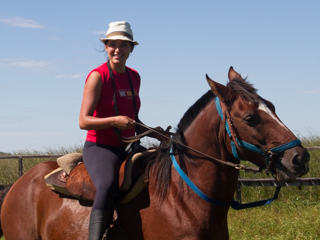
Lula, our volunteer in March & April
Monday, April 2, 2018
We were sorry to say goodbye to our latest volunteer,Lula, who has been a great help at the reserve. She also took an interest in our bat project and arrived with the necessary vaccinations. She was a part of the bat team that carried out research in Misiones at the end of March.
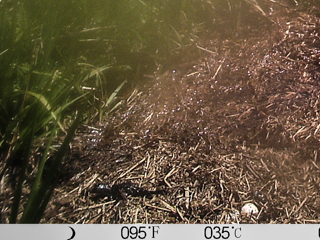
Cayman nest
Monday, April 2, 2018
Cepi placed a camera trap overhead a Cayman nest in order to find out more about the breeding cycle of this species, Caiman yacare. Females creat a large heaped nest out of vegetation and can lay up to 40 eggs, many of which will be predated by foxes, birds and other opportunists.
The photo shows a young Caiman that has just been born to the left of an egg.
It appeared from the images that other Caiman were interested in the nest close to the birthing event which may have been predation although we have no proof of this. It looks like some of the young have survived and the mother will take care of these for several months.
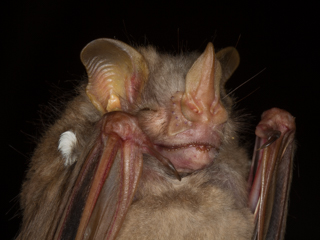
Bat team capture another species
Monday, April 2, 2018
The Collett Trust Bat Team went to Misiones for bat research at the end of March. We were invited by the owners of two distinct reserves and were delighted to catch Pygoderma bilabiatum, a medium sized fruit eating bat. It is a member of the family Phyllostomidae. We actually caught two in the net, one a post lactating female and the other a male juvenile.
Some of the striking features about this species are the two brilliant white markings on the shoulders. It has green eyes, in particular the juvenile, and the eyes are very bulbous. The inside of the ear and the tragus are yellow.
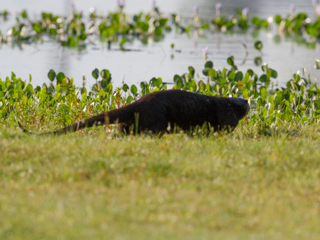
River Otter seen at Don Luis
Wednesday, February 21, 2018
This morning we spotted a Neotropical River Otter crossing one of the firepaths. When he sensed human activity he made a beeline for the water. We do not often see these shy creatures at the reserve although there are probably plenty of them.
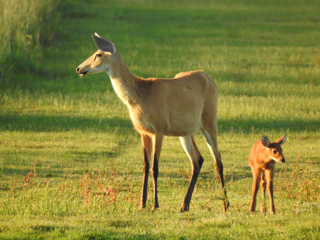
Another baby fawn at Reserva
Tuesday, December 5, 2017
We have had another birth at the reserve. This time the mother is Rocio, the daughter of Rosita, who was born on 02/01/2016. We noticed that Rocio was suddenly thinner and after a few weeks finally we managed to see the new faun. We are looking for a Guarani name that begins with A. We estimate that this new baby was born on 12/12/2017

Arandu getting larger
Wednesday, November 22, 2017
Rosita, our semi-tame Marsh Deer, often brings Arandu into the garden so we get to check that he is doing OK. He is totally a wild animal and we discourage too much human contact. He is growing well and looking healthy!
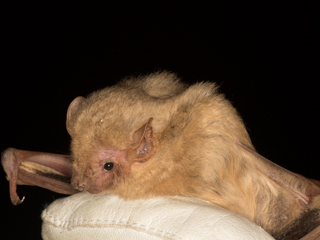
Southern Yellow Bat
Wednesday, November 22, 2017
We captured a nice example of Dasypterus ega a few days ago also known as Southern Yellow Bat. This is only the third time that we have come across this unusual species. All capture done under auspices of Parques y Reservas and all bats released unharmed.
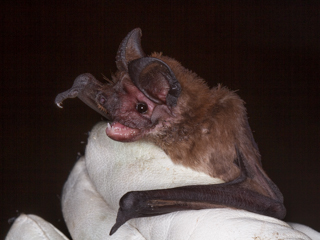
Yet another New Bat Species for reserve
Thursday, October 12, 2017
We managed to capture this beautiful Molossidae bat in our double high net a couple of nights ago. Initially we thought it was the common Eumops patagonicus but on measurement and careful examiniation we decided that it was the larger bonariansis. This is another first for the reserve.
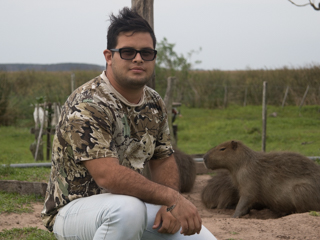
Volunteers at the reserve
Sunday, October 8, 2017
Martin has been a volunteer at our reserve for some time and we are very grateful for his help. He is becoming an expert on our vegetable plot which is very successful and is learning a lot about the birds of the reserve.
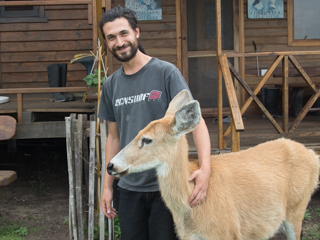
Volunteers at reserve
Sunday, October 8, 2017
Many thanks to Martin, (another Martin) for volunteering at Reserva Don Luis for a couple of months. He is learning a lot about our local bats and is very keen to learn more. He is also feeding our Bare-faced Curassow and monitoring his diet.
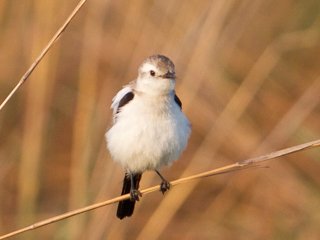
Black & White Monjita at Reserve
Monday, October 2, 2017
Finally we have photographic evidence that the Black & White Monjita has found its way to our reserve. We saw this female in the south last week and hope there is also a male. We have good habitat for this endangered species so expect it to eventually breed here.
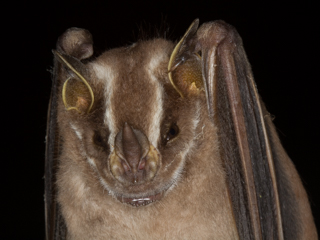
Another new Bat Species for Reserve
Monday, October 2, 2017
Another new bat species for the reserve. We set the Harp trap in Monte Sur, our woodland in the south, and caught two different Phyllostomidae bat species including this one which is Platyrrhinus lineatus. We have caught this bat before at an estancia about 150 miles to the east but did not expect to find it at our own reserve. The common name is White-lined Bat. It is a fruit eating bat and is med-large in size.
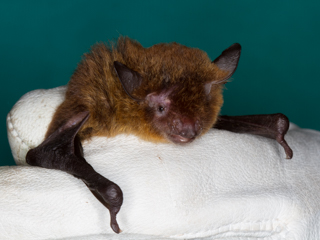
New Bat Species for Reserve
Sunday, October 1, 2017
We have been out in the various woodlands of our reserve conducting bat research using Harp traps and nets (under licence from Parques y Reservas). On Thursday we captured this beautiful orange coloured bat in our Harp trap and have identified it as Myotis simus. This is a new species for Reserva Don Luis.
We have since decided that this species in in fact a very orange example of Myotis riparius. We tend to see these orange examples in the spring and summer of Myotis riparius, Eptesicus furinalis and Molossops temminckii.
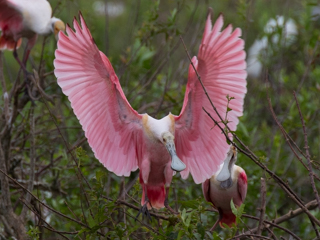
Roseate Spoonbills
Sunday, October 1, 2017
We already have a lot of Roseate Spoonbills in and around our reserve this year. On Wednesday we went to a nearby estancia which has a large heronry including Spoonbills. We spent several hours in this place which had at least 8 breeding species including hundreds of Spoonbills.
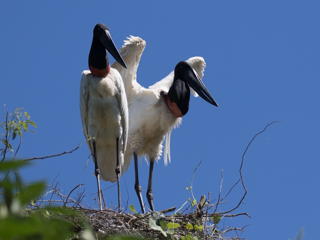
Tallest flying bird in Americas
Wednesday, September 20, 2017
We came across this large nest in Monte Grande during the trip in August. These Storks are Jabiru and are the tallest flying bird in the Americas. Happily they are still there and by now should be incubating eggs.
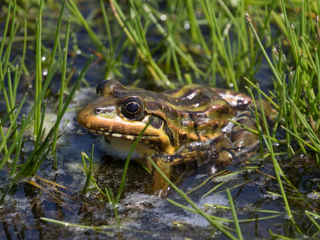
Leptodactylus latrans
Wednesday, September 20, 2017
This amphibian guards its young as we found out yesterday. She became quite aggressive when we looked at her tadpoles.
She lays the eggs in a cloud of foam (can be seen in photo) so predators are deterred from eating them. The young look to be a few days old with tails now.
It is a Leptodactylus latrans and measures around 12cm with quite striking markings. The common name is Oscellated Frog.
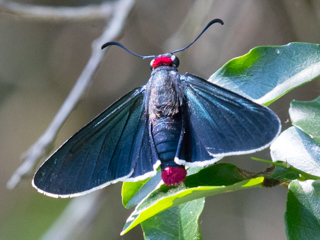
Beautiful butterflies
Wednesday, September 20, 2017
This morning I came across this rather stunning butterfly known as Diablito here or Little Devil. They are reasonably common in the Ibera Marshes.
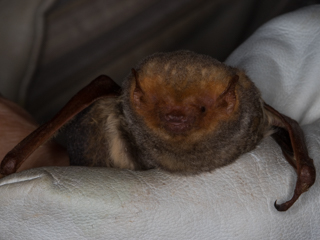
Lasiurus blossevillii
Wednesday, September 20, 2017
The last time we captured this beautiful species at Reserva Don Luis was in 2011 so we were very happy to capture it again in our nets in the south of the reserve on Monday night. We have a new volunteer who is keen to work with bats and so far we have been lucky with 4 Desmodus rotundus, 3 Myotis nigricans, 1 Lasiurus blossevillii and 1 Sturnira lilium.
It is known as Western Red Bat and is small/medium sized.
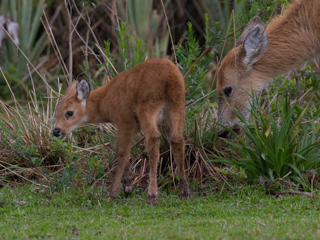
Arandu at 12 days old
Saturday, August 12, 2017
Here is a photo of the new faun born to Rosita 12 days ago with his mother.
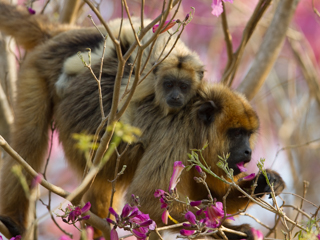
Howler Monkeys feasting on Lapacho flowers
Friday, August 11, 2017
There is not a lot of natural food around in the winter here at the reserve but our Black Howler Monkeys are enjoying the few weeks of Lapacho flowers of which we have many. This is a mother with her youngster onboard.
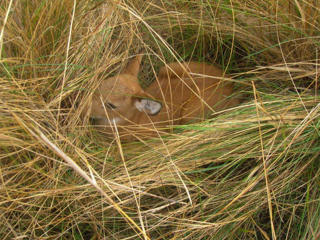
New baby Marsh Deer
Thursday, August 10, 2017
We are happy to announce the birth of another Marsh Deer faun to Rosita. He was discovered and photographed by Mario, our ranger, a couple of days after the birth so we estimate his birth date as 29/07/2017. We have named him Arandu which means 'intelligent' in Guarani.
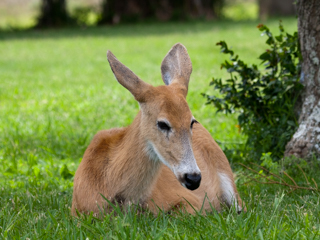
Rosita returns
Saturday, June 17, 2017
Rosita, our semi-tame Marsh Deer, who has been missing for over two weeks returned to the reserve yesterday as if she had never been away. She looked healthy and found her way into our feed shed to look for food. She was reunited with her daughter, Rocio, who will be delighted to have her grooming partner back.
We expect that Marito, her 8 month old latest offspring, will also be pleased to see her.
We have no idea where she has been!
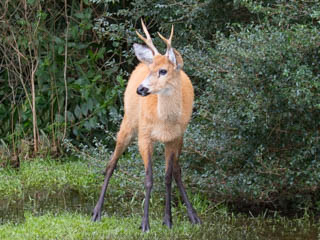
Many Marsh Deer taking Refuge in our garden
Wednesday, June 14, 2017
We believe that this young male Marsh Deer is Pablito who was born to Rosita 4 years ago.
He has been looking for his mother in our garden for a couple of days but fortunately looks healthy unlike some of the others.
We are all very concerned about Rosita our beloved semi-tame Marsh Deer who has been missing for over 2 weeks.
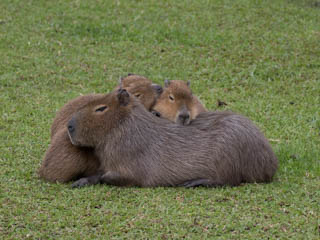
Capybaras doing better
Wednesday, June 14, 2017
The Capybaras in our garden are looking healthy fortunately. Most of the grass is above the flood line so they can at least get something to eat. We have however seen several dead ones along the access road (what is left of it).
This family of Capybaras are almost tame and are very cute.
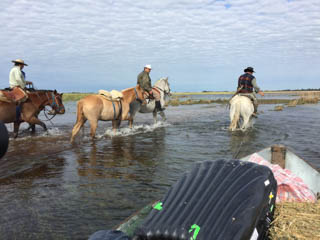
Next part of journey
Tuesday, June 13, 2017
The next part of our journey was by canoe pulled by Mario on one of our horses. This proved to be a very acceptable method of transport! We had the option of riding the horses but chose the canoe. Note the incongruous BA hold baggage alongside hay for our animals. Thank you Mario, Cepi and Lilo (one of our neighbours) for your amazing help.
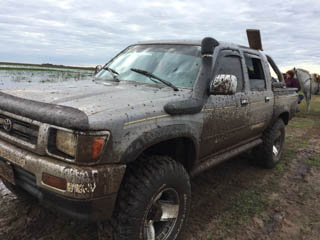
Access to Reserva Don Luis
Monday, June 12, 2017
Last Saturday Alejandra and I made the journey to the reserve utilizing several different modes of transport due to the severe flooding. Thank you Fabian for negotiating the make shift bridges in your amazing adapted Toyota Hillux with snorkel and getting us 3/4 of the way there.
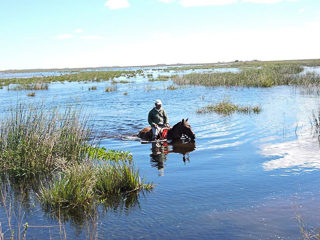
Flooding at Reserva Don Luis
Wednesday, April 12, 2017
During the last week we have had an unprecedented amount of rainfall. 450mm in total. As you can see from the photo of Cepi on horseback we are very flooded and can only get around on our horses. As the water table is this area is so high it will take a long time to drain away even though we are now having warm sunny days.
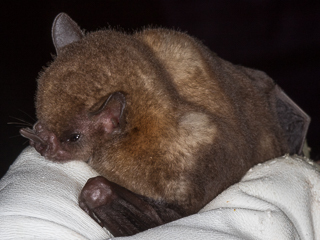
Frugivorous bat at reserve
Thursday, April 6, 2017
Last night we set up the double high net in the south of the reserve, away from the houses. We were delighted to find this species, Sturnira lilium in the net and the bat was extracted without harm, measured, photographed, recorded and released. This is the first fruit eating bat that we have captured at the reserve and it is from the family Phyllostomidae. We have been issued a licence by Parques and Reservas to conduct research into our local bats.
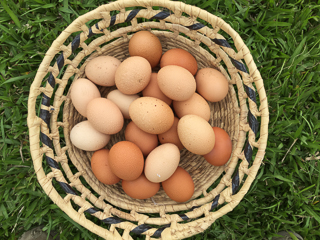
22 hens at the Reserva
Thursday, April 6, 2017
We are now getting between 7-9 eggs per day from our beautiful free-range hens. One of them kindly laid an egg on my galeria yesterday. We are gradually becoming more and more self-sufficient at Reserva Don Luis.
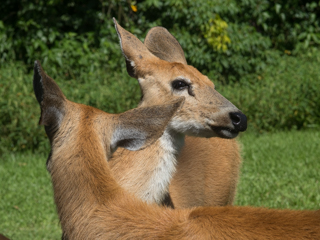
Rosita & Rocio grooming
Friday, March 10, 2017
Our semi-tame Marsh Deer, Rosita, is still taking a lot of interest in her daughter, Rocio, who was born in 2015. Rosita has a new baby now of around 3 months in age who we have name Marito. We often see Rosita and Rocio grooming each other and biting ticks off the other. Rocio is coming up to sexual maturity and we have seen a male Marsh Deer around quite a lot recently.
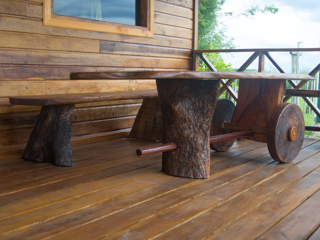
New Cabana furniture
Friday, March 10, 2017
We are gradually improving the new cabana that we have built for our volunteers. Cepi has designed and built some amazing rustic looking furniture that is stunning. This moveable table and bench seating is perfect for our volunteers and in keeping with the natural image of our reserve that we try to maintain.
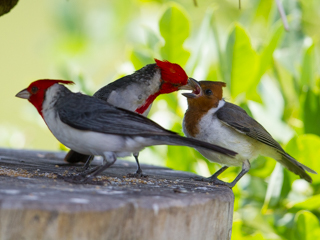
Red Cardinals Bred successfully
Monday, December 19, 2016
We were pleased to see that the Red Cardinals have once again successfully fledged two juveniles. The juv in the photo has the browner colouring on the head and chest. These are quite common birds in this region of Argentina but nevertheless they are stunning to look at. They are also intelligent and come and shout at me if there is no food on the bird table.
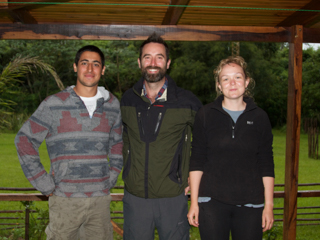
Film Crew at Reserve
Thursday, December 1, 2016
We have just spent 4 delightful days showing off our wetlands to a British film crew called 'Off the Fence' productions. They worked almost non stop on the production which will be shown by the National Geographic Wild series. Included in the filming were our Howler Monkeys, Caimans, Marsh Deer as well as some stunning scenery.
Great to meet you Poppy, Ralph and Santiago.
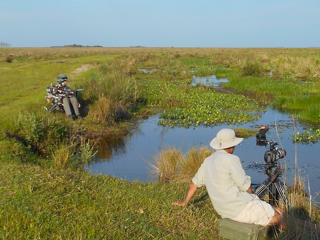
Filming Caimans
Thursday, December 1, 2016
'Off the Fence' film productions in action.
It took many hours of filming before the required shot was achieved of a Caiman catching a fish.
Photo courtesy of Alejandra Boloqui
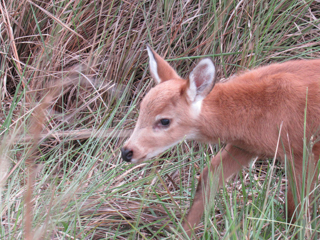
Newborn at Don Luis
Wednesday, October 12, 2016
We are happy to announce the birth of a new faun to Rosita, our semi-tame Marsh Deer. It was born during the early hours of Wed 19 Oct. and looks to be a healthy male although we will need confirmation of this. We hope that Rosita will bring her to show us but it is early days. Thank you Vicky for the photo
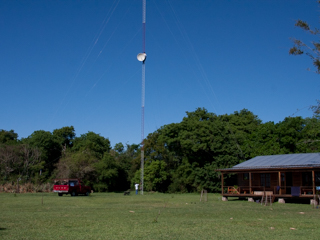
Internet returns to Don Luis
Tuesday, September 6, 2016
Excellent news from the reserve. We have had our internet reinstated after a diverse re-routing. The signal now comes from Posadas and is bounced off a tower in our local town of Ituzaingo back to the reserve.
Having been without it for nearly 2 years, we are overjoyed to have it back.
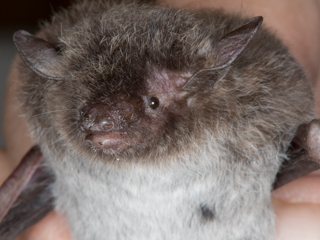
New Bat Species for Reserve
Monday, September 5, 2016
In August 2016 we managed to catch this bat in our Harp trap. Initially it looked like Myotis nigricans which we have caught several times but on closer inspection there were differences. Confirmation of species came when we released the bat and recorded its echolocation when flying around the garden. The calls of this species are of a high frequency compared with most Argentine bats.
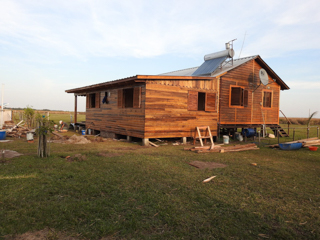
New volunteer's cabin
Sunday, August 7, 2016
We decided to add an independent extension to Mario's house as accommodation for our volunteers. Previously they stayed in the researcher's cabin but this only has space for 2/3 extra people which will not be enough for our future projects. The building is progressing rapidly and will be ready in around 2 weeks time. It consists of a bedroom, bathroom, galeria and small lobby.
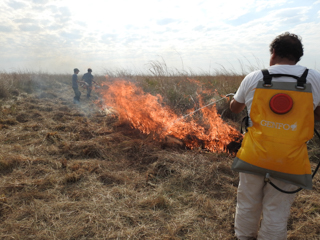
Controlled Burning
Sunday, August 7, 2016
Gustavo Marino returned to help us with some controlled burning as the conditions are now much dryer than when we were in El Nino. The conditions were a little windy but we decided to go ahead and burn selected areas in order to help prevent wildfires. Thank you to everyone that helped including Gustavo, Cepi, Alejandra, Sergio & Arturo
Also thank you Ale for this superb photo.
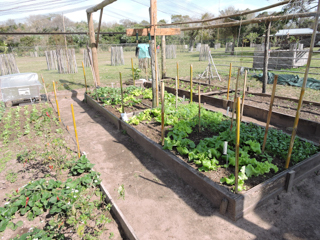
Veg plot improved
Sunday, August 7, 2016
Cepi and Mario have improved the vegetable plot. The roof has been raised so it is easier to walk around and we now have the ability to raise and lower the solar netting depending on the weather conditions. The lettuce looks good!
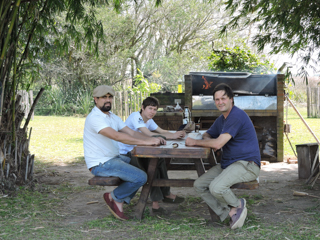
Gustavo with volunteers
Sunday, August 7, 2016
The photo is of Sergio and Arturo on the left with Gustavo Marino from Aves Argentinas, on the right. I would like to say a big thank you to Sergo and Arturo who regularly volunteer for us with everything from controlled burning of our grassland to bat research. We really couldn't do without you guys!
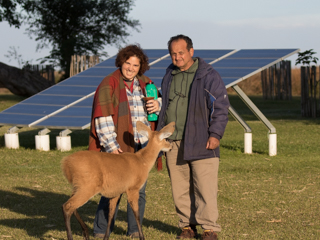
Alejandra, Cepi & Rocio
Sunday, August 7, 2016
We wish to thank Alejandra and Cepi, two of our trustees, for all the hard work that they put into Don Luis on a voluntary basis. We really could not manage without you both. Rocio also appreciates them - she is the latest offspring of Rosita, our semi-tame Marsh Deer. Although ideally Rocio should be totally wild, we are thinking ahead to the future when we lose Rosita (she is already around 10 years of age), so we are not discouraging Rocio from approaching us although we are by no means encouraging her.
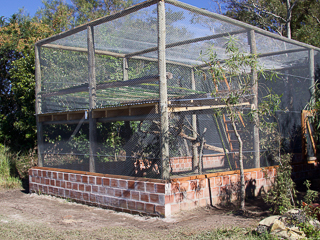
This may look familiar but......
Wednesday, June 15, 2016
Cepi and the team have spent the past couple of months constructing an identical aviary for our Bare-faced Curassow near to the houses. On Sunday we spent the morning trying to entice our male into a small cage in which we have been placing his food for the past week. Finally he entered and we remotely closed the door and were able to transport him by tractor to his new home.
He adapted very quickly and was eating within a few minutes. We think he will be happier closer to where the action is.
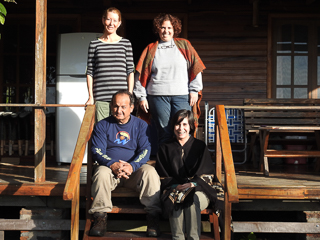
The FUCANA team
Wednesday, June 15, 2016
FUCANA stands for Fundacion Cambyreta para la Naturaleza and it is the Argentine branch of Collett Trust for Endangered Species. Here is a picture of our team - from left to right, top to bottom, Miranda, Alejandra, Cepi and Vicky.
We hope that Martin will join the team shortly and in the future we would like Jose, an environmental lawyer, to join us.
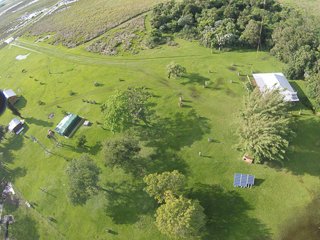
Volunteers needed for Sept onward
Wednesday, June 15, 2016
We are involved in three main projects at the moment. 1) Breeding program for Crax fasciolata - a highly endangered Cracid in Argentina. 2) Study of breeding habits of Alectrurus risora (VU) including ringing. 3) Study of bats of Ibera and surrounding areas.
We are looking for volunteers from around mid September.
Please contact us at info@collett-trust.org if you are interested.
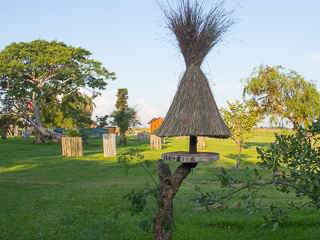
New Bird table at reserve
Saturday, April 16, 2016
Cepi, our chief designer, has come up with an usual and rather stunning new bird table.
The birds shunned it for a few hours only then the Great Kiskadees, Rufous-bellied Thrushes and Grayish Saltators braved the new table. The Red Cardinals are still a bit suspicious but will be using it very soon, I am sure.
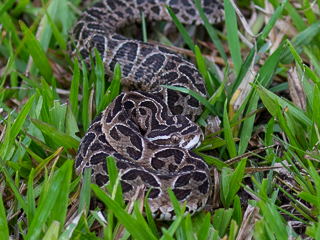
Pit Viper found on Galeria
Saturday, April 16, 2016
On a warm night a few days ago we encountered a Pit Viper (Bothyrops alternus) climbing up the hand rail of our veranda. This is a highly venemous snake! We captured it with snake tongs and the next morning transported it to a safe place faraway from the houses.
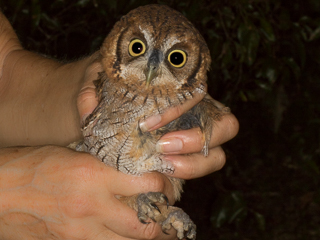
Tropical Screech Owl
Saturday, April 16, 2016
Whilst doing bat research on Sunday this small owl flew into one of our nets. It is a Megascops choliba (Tropical Screech Owl) which breed at our reserve. We untangled him within a minute and sent him on his way unharmed.
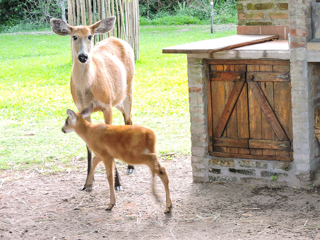
Name for Rosita's new baby
Saturday, February 6, 2016
Rosita is bringing her new baby in our garden regularly and seems happy to come quite close to us.
We are not yet sure if it is a male or female but historically she has shown us her male offspring more than the females.
We are trying to find a name for the baby - Spanish sounding would be more appropriate and preferably asexual.
Please send your ideas to info@collett-trust.org
Photo thanks to Alejandra Boloqui
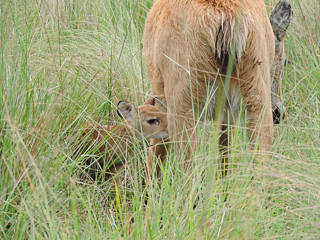
Rosita produces her 5th faun
Saturday, January 16, 2016
Rosita, our semi-tame Marsh Deer had her 5th baby at Don Luis a few weeks ago. We are delighted to receive these photos from Cepi and Abel of mother and baby. Rosita lost her previous baby due to a tick infection which devasted our population of Marsh Deer in the Ibera Marshes. Marsh Deer are considered Vulnerable according to the IUCN redlist
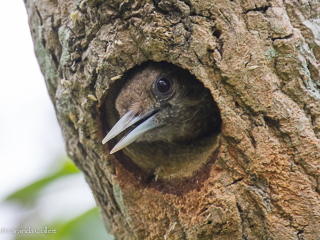
34 bird nests
Saturday, December 12, 2015
Cepi, one of our trustees, always maintains a keen interest in the breeding status of our birds at Reserva Don Luis. Last week he counted 34 active nests including Tropical Screech Owl, 3 types of Woodpecker, Jacana, Fork-tailed Flycatcher, Strange-tailed Tyrant, Guira Cuckoo amongst many others.
Next spring we are hoping to invite volunteers to help us to do a count and study of the nests of our Strange-tailed Tyrants (VU) as our reserve is one of the few places in South America where they breed.
The photo is of a Little Olive Woodpecker.
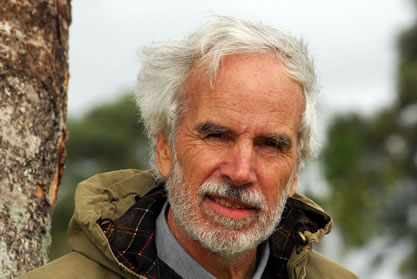
Sudden death of Philanthropist Doug Tompkins
Wednesday, December 9, 2015
We are very sad to announce the sudden death of Doug Tompkins from a tragic kayaking accident.
Doug was a conservationist supreme and owner of most of the land in the Ibera marshes which he has dedicated to conservation and returning to nature. He was a model and an ispiration to us all.
Our thoughts are with Kris and the rest of his family
We will miss seeing our neighbour, Doug, visiting Cambyreta from time to time. He was always helpful to our trust.
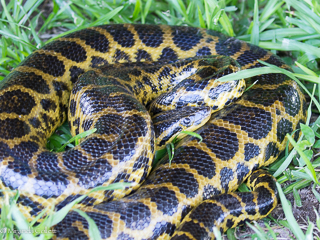
Yellow Anaconda
Wednesday, December 9, 2015
We found this beautiful Yellow Anaconda, Eunectes notaeus, outside our gate 2 days ago.
He was quite a small example at about 1.5m but no doubt will grow to up to 5 m in due course.
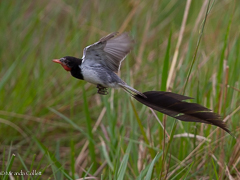
Study of Strange-tailed Tyrant
Saturday, September 26, 2015
We are doing a study of the nesting behaviour of the Strange-tailed Tyrant helped by our 2 volunteers.
We observed nest repair after storms and frequent visits by the female who alone tends to the nest and eggs. We saw her taking food in yesterday so looks like the chicks have hatched. We will be keeping an eye on this nest which appears to be quite early for this species.
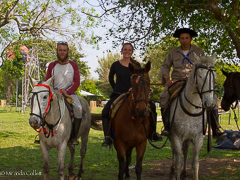
Latest volunteers
Saturday, September 26, 2015
We welcome James and Alex as our volunteers at the reserve for the next few weeks. Here they are joined by Maurio.
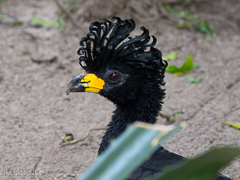
Looking for a Mate for Tito
Saturday, September 26, 2015
Our Bare-faced Curassow is very content in his large aviary but we think he is looking for a female. We are dong everything that we can to find him one but it is difficult here in Argentina.
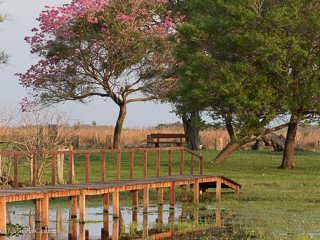
Lapachos at Reserve
Tuesday, August 25, 2015
The Lapachos are beautiful this year. They are loved by the Howler Monkeys and the flowers form a large part of their diet at this time of the year. The Hummingbirds are also very partial to the flowers. This photo includes a part of our new bridge.
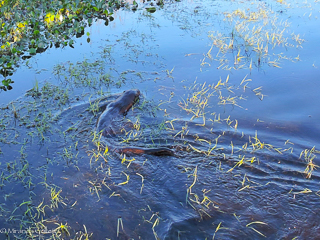
Otters displaying around new bridge
Saturday, July 4, 2015
In mid June we were priviledged to see 3 Neotropical River Otters swimming together near the houses. One of our volunteers, Edith, was standing on the new bridge and saw these Otters displaying. They are classed as Near Threatened and decreasing in the IUCN redlist due to loss of habitat and pollution. Photo courtesy of Edith Villordo
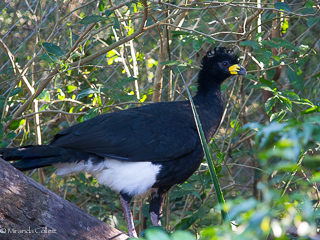
Curassow settling in well
Tuesday, June 16, 2015
Our Bare-faced Curassow is doing really well. His behaviour is now very relaxed and he uses all of the corral with favourite places being the bamboo perches we put up for him and the large trunk placed from the ground to the top level. His favourite food is grapes and banana although we are trying to introduce native fruit.
We feed him twice a day with grain and fruit and study his behaviour. He also appears confident around his keepers.Edith is doing another 2 week stint as volunteer which is good news for us.
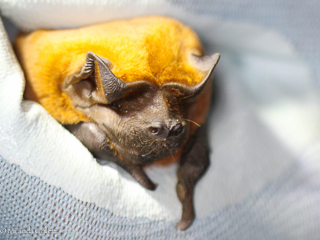
Black Mastiff Bat
Tuesday, June 16, 2015
We did some bat trapping for ID at a nieghbours place on Wednesday and managed to caapture 5 Black Mastiff Bats (Molossus ater). There was an amazing variation in colour from the bright yellow of the one above to red for one of the others. They are relatively large for an insectivorous bat weighing about 30grams.. We are slowly building up our library of bats and record their echolocation when we release them.
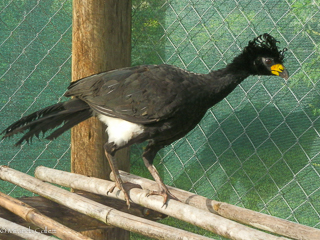
Bare-faced Curassow at Don Luis
Saturday, June 6, 2015
Finally we can announce that we have a male Bare-faced Curassow - IUCN Vu but endangered in Argentina and extinct in Corrientes. He has been with us since 01 April and has adapted well to his new super-large aviary.
He may be a candidate for release in the future as his reactions are superb. This is the first example of this species in the Ibera Marshes for many decades and there has been quite a lot of publicity about it.
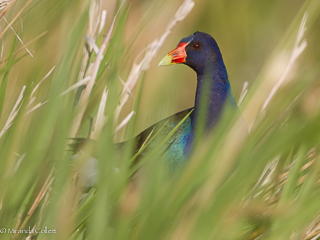
Purple Gallinule at Reserve
Monday, March 23, 2015
We saw this species at the reserve in 2010 but have not seen it again until yesterday. It is a difficult bird to see as it skulks around the bottom of the reeds but I managed to glimpse it long enough to photograph.
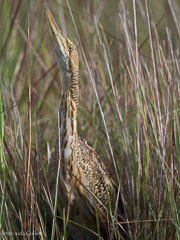
New Bittern species seen at Don Luis
Sunday, February 22, 2015
Last week we saw this species in the south amidst the reeds. It is called Pinnated Bittern or Mirasol Grande in the Argentine language. It is a large bird and the first time that we have encountered it at the reserve. Also during the last trip we saw many Least Bitterns and two Stripe-backed Bitterns.
.jpg)
Many young Marsh Deer at Reserve
Sunday, February 22, 2015
We have seen many juvenile Marsh Deer at the reserve during the past week signifying a good breeding season. We are very much a wetland at the moment due to El Nino weather conditions and there is plenty to eat for this species.
.jpg)
Many juvenile Strange-tailed Tyrants at Reserve
Sunday, February 22, 2015
We have seen several juvenile Strange-tailed Tyrants during the past week. It looks like this species has had a successful breeding season with several clutches per female. We expect this population to grow significantly over the next year or two as this is ideal habitat for this species and is undisturbed.
.jpg)
Tropical Screech Owl juvenile
Wednesday, December 17, 2014
This year the Tropical Screech Owls have had one chick. It is already flying and hunting but is being watched carefully by its parents.
They breed in the large bamboo plant just outside our house and emerge around dusk. They are known as Alicucu Comun in Argentina
.jpg)
Pablito visits his mum in garden
Thursday, December 11, 2014
Early yesterday morning we were visited by Pablito the faun of our semi-tame Marsh Deer, Rosita. He was born in December 2012 so is currently 2 years old. He is a completely wild animal but appeared to be quite confident around us. He is a very healthy looking animal as are the other offspring of Rosita who has had 4 fauns since we first met her.
.jpg)
Aves Argentinas at Don Luis
Friday, December 5, 2014
We were very honoured to entertain Horacio and Cristian from Aves Argentinas on Sunday. Horacio is the Coordinador de socios and looks after the COAs in Argentina amongst other things. It literally poured with rain for most of the time they were with us but it did not stop us from observing some of the best birds of Reserva Don Luis. We saw several Strange-tailed Tyrants, Least Bittern, Stripe-backed Bittern, Azure Gallinule as well as the un-named Seedeater which has been nicknamed Capuchino Ibera.
We all had a good time and hope they will come back and visit.
Pictured here with Rosita our semi-tame Marsh Deer, Cepi Oporto, Alejandra Boloqui, Arturo Roselli, Christian Bisiau and Horacio Matarasso.
.jpg)
4 Azure Gallinules seen at Don Luis
Saturday, November 29, 2014
Porphyrio flavirostris
We went riding to the south west early this morning and came across 4 Azure Gallinules which are rare in Argentina. Two were together but the other two were apart so we probably have several famiies in this area. Their preferred habitat is reeds in areas of water far from disturbance. They are very difficult to see as they skulk in the reeds and rarely come into the open.
We also saw a family of Strange-tailed Tyrants about a km to the west of the house, with 1 male, 3 females and several juveniles as well as 6 Marsh Deer.
.jpg)
Strange Behaviour for this Dark-billed Cuckoo
Friday, November 28, 2014
Unlike European Cuckoos the Dark-billed Cuckoo from the neotropics is not a nest paracite and normally rears its own offspring. We were therefore surprised to see this Cuckoo on Camera trap laying eggs on 2 occasions in the box we put out for our domestic hens.
Unfortunately we also saw a Black Tegu (large lizard) entering the hen nest box so presumably he ate both the hen's eggs and those of the Cuckoo.
.jpg)
Patagonian Dwarf Bonneted Bat
Monday, October 20, 2014
We caught this cute looking bat in 2011 and again caught it in our mist nets during late November. It's latin name is Eumops patagonicus and the common name is Patagonian Dwarf Bonneted Bat.
It is from the Molossidae family and has a free-tail, a small to medium insectivore with large fleshy ears that meet in the middle.
-2.jpg)
Many Strange-tailed Tyrants
Sunday, October 19, 2014
This trip to the reserve in November we have come across many Strange-tailed Tyrants - males, females and juveniles. Their main breeding period is early October and late November for those that have another clutch. Both males and females have their own territories and a male can mate with up to 3 females.
.jpg)
Cassie our volunteer for Sept/Oct
Saturday, October 11, 2014
Cassie volunteered for us during Sept/Oct and has been a real asset to our team at Reserva Don Luis. She is pictured here with Rosita and Michael, the enforcer for our trust.
She was invaluable in helping with the bat surveys and looked after our orphan baby Capybaras amongst many other jobs.
Thanks a lot Cassie! You are very welcome to come back anytime.
.jpg)
New bat species found at reserve
Saturday, October 11, 2014
We did some bat trapping last week to try to identify some of our species at the reserve. Over 2 nights we managed to trap 10 bats, 2 of which escaped before we were able to ID them. The 8 bats were measured, weighed and photographed and it was decided that they were Drawf Dog-faced bats, Molossus temminckii, probably the ones roosting in the research cabin.
One of the escapees looked to be larger and a different species so we need to try again.
Thanks to Parques and Reservas for permission to do this survey work.
.jpg)
Seedeater unidentified
Saturday, October 11, 2014
We are seeing a lot of these seedeaters (Sporophila) at the reserve and surrounding areas which we first saw in 2010. They are relatively common but up until now have not had a specific name. They are a hybrid between similar seedeaters but are visually very different and have a different call.
.jpg)
Rosita on the run
Saturday, October 11, 2014
This male Marsh Deer has been hanging around our garden for a couple of days lusting after Rosita who is presumably on heat. As usual she is paying him no attention and lies with her back to him or runs when he gets too close.
He is almost certainly the father of 3 of her offspring so far so there does appear to be some monogamy amongst Cervidae.
He has a bad habit of destroying our new trees by rubbing his antlers on them.
.jpg)
Rosita's new baby
Wednesday, September 24, 2014
Ramon found this new baby Marsh Deer in the grass on Sunday. It is a male and is about 2 days old in the picture.
This is Rosita's fourth baby that we know of since we first encountered her in 2011. We hope she will bring him into the garden to show us.
The Marsh Deer is considered to be Vulnerable according to the IUCN redlist.
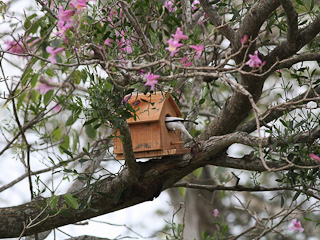
White Monjita using Nest Box
Wednesday, September 3, 2014
We put up several nest boxes 3 weeks ago and within 2 weeks this one was being used by a White Monjita. These are beautiful birds albeit quite common, but we are very happy that they have found this box so quickly. We plan to put about 50 boxes in Monte Grande and Monte Casa.
Many thanks to Alejandra and Cepi for organising the construction of the boxes, for their good ideas and for erecting the boxes.
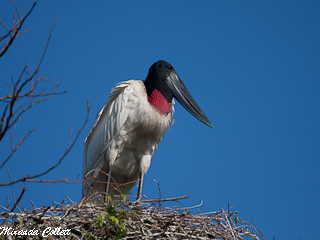
Jabiru nest in Monte Grande
Monday, August 18, 2014
Last year must have been a good one for the Jabiru - the tallest flying bird in the Americas. We are very pleased that one pair have chosen our largest wood, Monte Grande, as a place for their nest.
We think the eggs have been laid so hopefully we may see the chicks on my next trip in September.
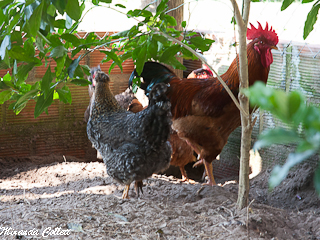
Happy hens
Monday, August 18, 2014
We have had 3 hens in our bird corral now for 2 months and the cock bird for about a month They all seem content and the predators have not been able to get in (foxes, Geoffroy's Cat, Possums, Stoats etc). We have had 3 camera traps trained on the aviary to see if the predators are proving to be problematic but there is no way in which they can get in so we are happy to receive our Bare-faced Curassows now with the confirmation that the cage is safe.
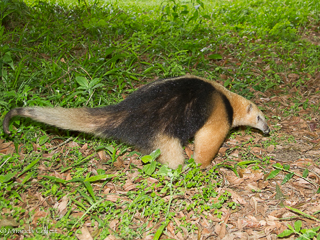
Southern Tamandua seen by Ramon
Sunday, July 6, 2014
Our latest recruit to Don Luis was spotted by Ramon, our ranger last Wednesday. She was brought to Don Luis a couple of weeks ago with the intention of feeding her in our incubation room for a few weeks before releasing her. Unfortunately she broke a window and escaped through the mosquito netting on night 1 and has not been seen until last Wednesday.
She looked healthy and is obviously finding enough food in our local wood. I would like to put a radio transmittor on her, although this is not easy with her narrow neck, and would have to be a harness of some kind. Unfortunately I am not due to return to Don Luis until September and we are not sure if she will still be in the local area.
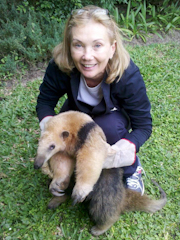
A second Southern Tamandua at Don Luis
Sunday, June 22, 2014
This beautiful Southern Tamandua was discovered in a tree in our local town which is not a suitable place for this species. After the appropriate paperwork and authorisations were completed she was taken to Don Luis to be released. In this photo she is being attended to by Liliana Pintar, our project vet.
.jpg)
Otters seen at Reserva Don Luis
Thursday, June 12, 2014
Yesterday, Tuesday 10 June, we saw a family of 3 Otters in the south of our reserve. Later another one was seen crossing the path between the water bodies.
We are always happy to see these delightful mammals and this seems to be the time of year when they are most visible.
.jpg)
New bat species found at reserve
Wednesday, June 11, 2014
On 03 June we found this beautiful large bat roosting in a bamboo plant. It is called Lasiurus ega or Southern Yellow Bat and is from the Vespertillionidae family.
Athough not outside of its range, it has not been found in the Ibera marshes before so we were priviledged to find it.
Please never handle a bat in this way - it should not be suspended by its wings!
.jpg)
Bird ringing at Reserve
Wednesday, June 11, 2014
We had permission from Parques & Reservas to do some bird ringing at Don Luis last week. During the duration of the course we managed to ring 45 birds including 15 different species.
This picture is of a epaulet Oriole, Icterus cayanensis. We will now do some studies on the birds that we see with rings around the woods.
Thank you to Juan Klavins for his excellent demonstration.
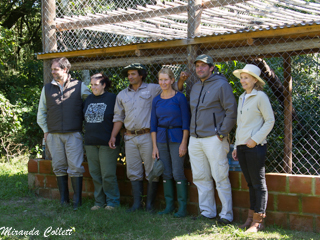
Proyecto 'Muitu' Team members
Tuesday, June 10, 2014
We had an asado at Reserva Don Luis on Sunday for the Team members of the 'Muitu' project which is taking shape.
From left to right - Lissandro Cardinales, Alejandra Bologui, Ramon Gomez, Miranda Collett, Abel Yunis and Liliana Pintar.
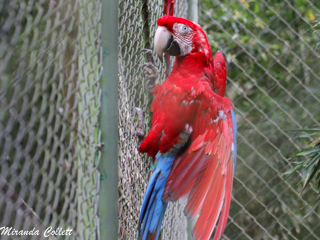
Red Macaw
Saturday, May 31, 2014
The Red Macaw is the second bird that the authorities are permitting to be re-introduced into the Ibera Marshes. We would love to host this project too but will certainly need to prove ourselves with the Bare-faced Curassow first.
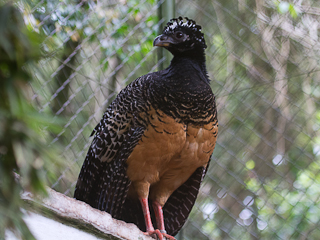
Good news about our project
Friday, May 30, 2014
Finally we have some constructive news about our re-introduction project.
On Monday 02 June an agreement between CONICET and the Director of Natural Resources will be signed to permit re-introductions of 2 bird species into the Ibera wetlands. These birds are the Red Macaw and the Bare-faced Curassow, both of which are endangered in Argentina. The latter is the bird that we have been concentrating on during the past 2 years and we hope that this will permit us to advance with our project.
We are having many meetings this week to discuss the issue.
The project is a joint venture between the Collett Trust and Coa Carau. The latter is our local bird group which is affiliated to Aves Argentina, the equivalent to RSPB or BTO.
 (1 of 1).jpg)
30 juvenile Spectacled Caiman found
Sunday, April 20, 2014
We were surprised to find about 30 juvenile Spectacled Caimens at the edge of our garden with no mother in sight. They were quite delightful although already armed with excellent reactions. Our volunteer Ed was kept well occupied with measuring and weighing some of these specimens. We put them all back where we found them and they were gone the next morning.
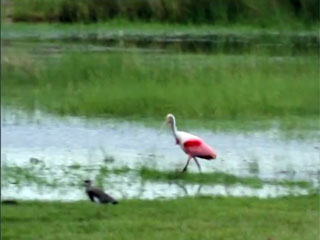
ITV Channel Video
Sunday, April 6, 2014
The Reserve was recently featured on ITV Channel news in the UK. I've posted a link to the video on the About Us page. It's also up on YouTube. Please help promote our work to preserve endangered species by sharing it on your social media. The YouTube link is here
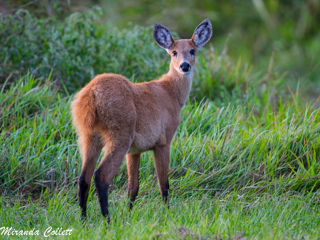
Rosita's new baby
Sunday, April 6, 2014
Finally we have seen Rosita's new faun. She brought it into our garden this morning and although it moved away when it saw us, we were able to take some photos. We think it is a female and hope it will be a little tamer than her first female faun.
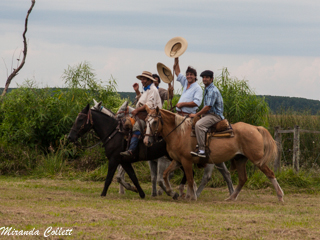
Gauchos a Reserva Don Luis
Monday, March 31, 2014
Some cousins and neighbours got together to round up Juan Martin's cattle to vaccinate against foot and mouth. This is performed routinely in Argentina unlike Britain where we suffer a disastrous outbreak of the disease every 15 years or so and have to pay farmers millions in compensation.
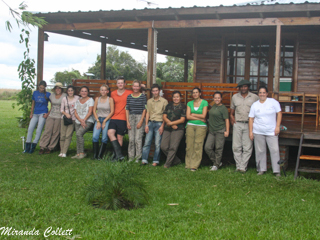
Camping at Reserva Don Luis
Monday, March 31, 2014
At the weekend we entertained 10 members of COA Carau including a few from Birding Virasorro. Unfortunately the heavens opened just as they all arrived and camping took place in the researchers cabin with food on the galleria. It finally stopped raining at about 1100 on Sunday and we were able to go out and look for some birds
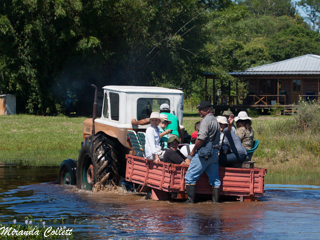
Virasorro bird club visit
Friday, March 28, 2014
We entertained 16 members of the Virasorro bird club on Monday and had a lot of fun. As usual, Rosita our tame marsh Deer got in on the act and tried to steal our food. This is transport for those who chose not to walk to our largest wood, Monte Grande.
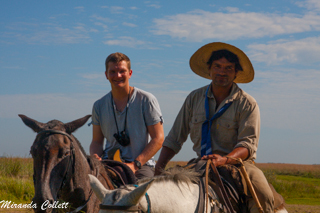
Our new volunteer on horseback
Friday, March 28, 2014
Ed and Ramon on horseback. Ed is here for 3 weeks doing a study on our reptiles
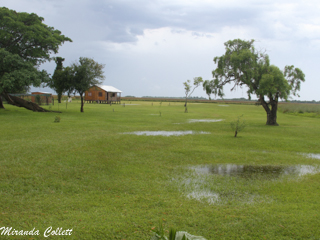
Torrential rain at Reserva Don Luis
Monday, March 17, 2014
We arrived at Reserva Don Luis today in torrential rain. Our weather machine tells us that we have had 120mm in less than 24 hours which is excellent news. We are back to being a wetland and everything looks lovely and green and healthy.
The drive down our 32km sand road was interesting but we are lucky in that it is never muddy or slippery and it drains very quickly.
Rosita the Marsh Deer was there to greet us and of course we had to feed her some bread.
We are expecting a new volunteer to arrive on Thursday, Ed, who will be conducting a study on our reptiles.
.jpg)
3 new Trustees for Collett Trust
Friday, March 7, 2014
We would like to welcome 3 new trustees to the Collett Trust for Endangered Species.
Martin Bossart
Alejandra Boloqui
Cepriano Oporto
They have given us a lot of help over the past couple of years and we are delighted that they wish to get a bit more involved.
I will be returning to Reserva Don Luis on 17 March for almost a month and hope to provide more photos and news.
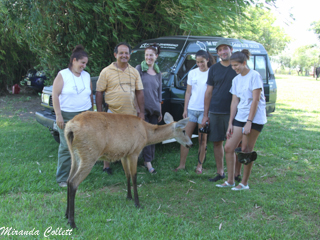
Visitors to the reserve
Friday, January 24, 2014
We had some visitors to Don Luis on Tuesday. Ale & Cepi brought along a truckload of people including Abel, who we have not seen since September. Abel is involved in our re-introduction project.
Naturally Rosita had to get in on the act and whilst we were looking at the Howler Monkeys she stole a Pan Dulce and a ham tart. As she is supposed to be vegetarian this is a bit worrying.
Unfortunately I did not see her new offspring during my short trip in January although I implored her to show me. We assume all is well as she is definitely lactating.
New birth at Reserva Don Luis
Wednesday, January 8, 2014
We are very excited to learn that Rosita has produced another beautiful faun. This is the 3rd offspring that she has had since we first encountered her in 2011 so in our opinion she is a very successful mother.
I will be going out to the reserve on 15 Jan and cannot wait to see the new baby. Hopefully we can take some more photos.
Thanks to Juan for taking this photo.
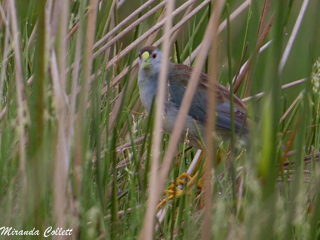
Azure Gallinule at Reserve
Wednesday, December 4, 2013
We have heard these Azure Gallinules in the past and saw one about 2 years ago but right now we appear to have at least 2 birds if not 3. These birds are very difficult to see as they skulk around at the bottom of reed beds and almost never come out into the open. This shot took several days of going out at dawn, waiting to hear their call and many hours of patience until finally we had a sighting.
This bird is rare in Argentina where it has a small localized range.
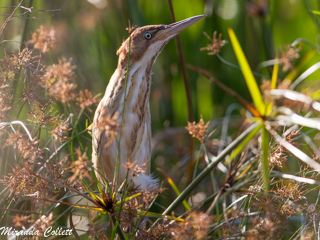
Least Bitterns
Monday, December 2, 2013
We are hearing and occasionally spotting many Least Bitterns at the reserve.
This shy, secret bird is very difficult to spot as it spends most of its time in the reeds and will only fly if it is disturbed.
We also saw an Azure Gallinule a few days ago. This is only the second sighting at the reserve of this species - unfortunately the photo was not good enough to show.
 (1 of 1).jpg)
3 juvenile Strange Tailed Tyrants seen
Monday, November 25, 2013
Yesterday we saw 3 juvenile Strange-tailed Tyrants in the south feeding in the tall grass. They looked to be about 3 weeks old, according to the length of the tail ,so it looks like they bred here at Don Luis or very closeby.
We are delighted to see 3 young of these endangered birds as we were worried that they had all left the area in October.
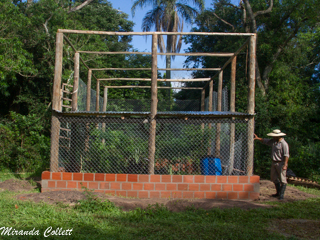
New Bird Aviary
Friday, November 22, 2013
We are very proud of our new bird aviary which is almost complete. This has been constructed on the edge of our largest wood 'Monte Grande' which is a 20min walk from the houses.
We cannot use regular vehicles to get there as it is too wet so we have been transporting the equipment, materials and workforce by our tractor and trailer.
We hope to complete it early next week then we will be ready to receive our 2 Bare-faced Curassows when all the relevant paperwork is completed. We have the radio tracking equipment ready for use.
.jpg)
Another new species seen
Wednesday, October 9, 2013
We saw this Rail on our penultimate day early in the morning presumably out in the open looking for food. These birds are difficult to see as they spend 95% of their lives hidden in the reeds. If you are lucky you may hear their call.
Its English name is Spotted Rail and it is a member of the Rallidae family. The Argentine name is Gallineta Overa.
This was one of 10 new species seen during the trip, most of them 'Lifers'.
Our wetland in the south is probably full of Rails, Bitterns and Crakes but you have to be in the right place at the right time to see them.
.jpg)
Progress with Reintroduction of Bare-faced Curassow
Wednesday, October 9, 2013
We have made slow but good progress toward our reintroduction project for the Bare-faced Curassow.
During the recent trip we saw several of these birds in captivity. We think we may be able to get hold of a non-breeding pair to access habitat suitability and to monitor their behaviour. These birds could also be foster parents for the chicks we hope to incubate.
Genetic and disease tests are currently being carried out on these birds and we are preparing a large aviary in our largest wood in which to house them before a soft release. Our incubator room has been ready since March and we are prepared at any time to start incubating when we get some eggs.
We have ordered radio tracking devices for when the birds are released and will probably need volunteers in the near future.
This is a very exciting project and will be the first reintroduction of a Cracid in Argentina.
The photo is of the female that we hope to have. Photo courtesy of Alex Roberts
.jpg)
Osita is back in the wild
Tuesday, October 1, 2013
We are sad to lose Osita, our Southern Tamandua, but happy that she has recovered and obviously wants to be free.
We trained her to eat her food from a bottle so that other animals were unable to access it. She has a tongue of about 40cm and has no trouble reaching the liquid at the bottom of the bottle, which we secure in a small cage attached to the ground.
She has put on about 500grams in weight and is looking healthy and recuperated. Yesterday she ate well, as usual, but did not seem to want to sleep as she normally does throughout the day. We tracked her for a long time but eventually we lost her and are not sure if she is even in our local wood.
We wish her the best for a healthy and free life.
.jpg)
Tamandua at Reserva Don Luis
Tuesday, September 24, 2013
We are very fortunate to have acquired a rescued Southern Tamandua for the reserve. Thank you Ale and Cepi for thinking of us.
She arrived in a bad state with a gaping maggot infested wound to her wrist plus a cut under her eye. She was looked after by our friends in Ituzaingo then Alex, our volunteer, brought her to the reserve in a large cage and looked after her, with the help of our ranger, for a couple of days before I arrived.
She is now bouncing around and is very curious about her new surroundings. She has a large appetite and her wound is slowly improving although we are hoping a vet will come soon to help.
She is an amazing animal with a prehensile tail and huge front claws which she has never used agressively towards us.
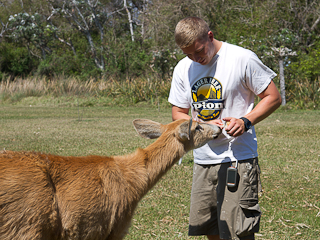
Rosita returns
Saturday, September 7, 2013
Rosita, our tame Marsh Deer, has been missing for almost a week and we were getting a bit concerned.
Thankfully, she returned to our garden this morning and is getting to know Alex, our volunteer.
I think they will get on fine especially if he gives her bread.
.jpg)
Brazilian Porcupine
Saturday, September 7, 2013
We re-visited El Puma Ecological Park on Wednesday and were impressed with the developments at this refuge Centre. They have designed a new spacious enclosure for the Jaguars which will give them much more area to roam and a pond in which they can cool down.
They have a beautiful baby Neotropical River Otter which runs around with their dog as well as a very young Tamandua which was attacking an anthill when we saw him.
We were really there to meet with the director with a view to possibly having 2 Bare-faced Curassow that currently live in the park at our reserve.
This beautiful little rodent is called a Brazilian Porcupine and was personally being looked after by the director in his office.

Bare Faced Curassow
Tuesday, September 3, 2013
We went across the Parana river today to a Wildlife rescue centre in Paraguay. I was pleased to see that they had several examples of the Bare-faced Curassow. Here is a picture of one of the females.
This is the species that we hope to reintroduce into our reserve. The Centre could also be a source of eggs for us but I am not sure about moving eggs across international boundaries.
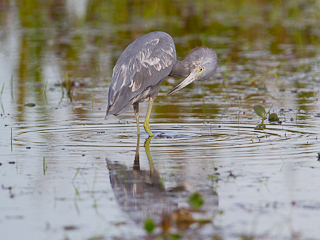
Little Blue Heron
Saturday, August 31, 2013
The Little Blue Heron is fairly common in parts of the USA but is quite rare here in Argentina.
We spotted this juvenile fishing in shallow water about 4km to the north of us. It is slowing getting its blue plumage but starts out as a completely white fledgling.

Visitors to Reserva Don Luis
Saturday, August 31, 2013
Yesterday we had a large party of trainee eco-guides who came to see our Howler Monkeys and Caimans.
All very charming people and we welcome them back at any time.
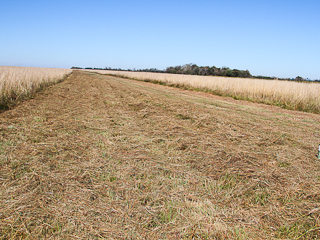
Runway at Reserva Don Luis
Friday, August 30, 2013
We are expecting some friends to arrive by light aircraft in a couple of weeks and have decided that rather than use our neighbours airstrip we could modify one of our contra-fire paths.
This photo is half-way down the runway looking toward the south. There is a slight curve in the middle which we are trying to reduce but the total length is nearly 800m which is more than sufficient and it favours the prevailing winds which are either north or south.
Ramon, our ranger, and one of his sons has been out the past 2 days filling any large holes in the runway.
It will involve our friends wading through a shallow lagune on disembarking but hell nothing is perfect in the wilds of Ibera!
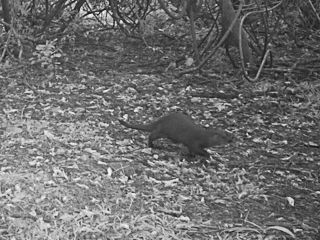
Otters seen at Reserva Don Luis
Friday, August 23, 2013
During the past 2 months we have observed images of Neotropical Otters on our camera traps. At the moment we are concentrating on this species and have placed all of the remote cameras in 2 of our small wooded areas. Although this is not their typical environment, they seem to use at least one of these woods as a corridor.
We have had 5 recent sightings of this species, only one at a time, and normally by day. Usually we see them by night in the summer but they may prefer to be diurnal in the winter (similar to the Giant Anteater in this area).
They are considered to be data deficient according to IUCN (but probably decreasing), and endangered in CTES appendix 1.
Other interesting news is that we now have 1 adult male Strange-tailed Tyrant, already starting to get the red throat, and 6 adult females in our area. They may stay to breed but we could do with another male!
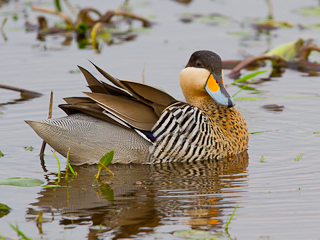
Back to Reserva Don Luis
Sunday, August 18, 2013
We arrived in the town of Ituzaingo this morning by overnight bus and had a very pleasant drive to the reserve. There appear to be more birds than usual with large flocks of White-faced Ibis (Cuervillo de Canada), plenty of elegant South American Stilts (Tero Real) and for the first time since I have been here several pairs of Silver Teal (Pato Capuchino).
It is a bit on the dry side, but there is still plenty of water around for the fauna that need it. We may need to think about some anti fire measures though as the neighbouring farmers are burning their grass all around us.
The incubation room and kit is all ready to roll and now we just have to wait until we can get some eggs of the Bare-faced Curassow.
Shots from the camera traps have featured several Neotropical Otters so looks like we are getting more of these beautiful creatures.
Picture is of Silver Teal. They have very attractive bills.
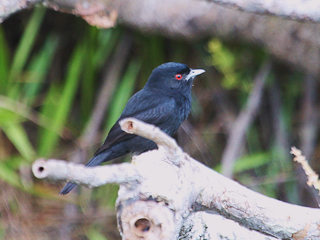
New bird species at reserve
Wednesday, June 12, 2013
We have just returned from an excellent 5 days at the reserve. It has never looked better and one would not know that we had had such a devastating fire only a year ago.
We have seen Rosita every day, occasionally with her fawn and also seen Srange-tailed Tyrants on 2 occasions. We have heard the Maned Wolf calling early in the morning and seen its footprints just outside our front gate. The 2 Greater Rheas have moved to the south of the reserve and may even be in our neighbour's farm but I am sure they will return.
New birds this trip have been the Blue-billed black Tyrant,(see photo) and we have more photos of the Anhinga and the Cream-backed Woodpecker from the river Parana which lies 35km to the north of us. We also have photos of the Barn Owl and some new ones of the Tropical Screech Owl.
The new incubator shed is superb and we are now ready to start incubating in the Argentine spring.
Looks like the reintroduction project for the Bare-faced Curassow will go ahead and although we are short of any details at present we are very excited.
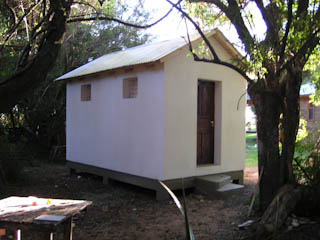
Incubator shed almost complete
Sunday, March 31, 2013
Thanks to recent good weather at the reserve, the builders have managed to complete the incubation shed. I have only seen the photos so far but it looks good. I will be going to see it in early June
Other news: hunters have been heard in the area and some arrests have already been made. We are keeping a careful eye out and doing regular patrols on horseback.
.jpg)
We are, once again, a wetland!
Wednesday, March 27, 2013
We are back at Reserva Don Luis and what a fantastic change. We have had 402mm of rain in March, so far, and everything looks healthy and green and the animals are appearing in droves. Each time we go out on horseback we see double figures of Marsh Deer and so many Capybaras. Lots of Egret and Roseate Spoonbills. There are also Strange-tailed Tyrants around - we saw 8 a few days ago, all juveniles.
Our internet is still not working so editing the website is difficult. Lots of pics to come.
.jpg)
New baby for Rosita
Monday, January 21, 2013
Rosita, our tame Marsh Deer, has delivered another faun, this time a male shown in the photo at about 1 month old. We have named him Pablito. He appears to be tamer than her faun from last year but that might be because he is so young.
During our trip to Reserva Don Luis in January we have seen many of these endangered deer which have returned in force now that we are once again a wetland.
Threats to this species in this area are few, mainly due to disease caught from cattle. They have no predators although there are plans to reintroduce the Jaguar here in the future so things may change. We are fortunate in that we are so far from the main road that hunters are unlikely to travel as far as our reserve especially as they have to pass the provincial Guardeparke station en route. This deer is also protected so it is highly illegal to hunt them.
See our page on the Marsh Deer.
.jpg)
Maned Wolf seen at Don Luis
Monday, January 21, 2013
We went horseback riding at dawn last week and on both occasions were lucky enough to see one of the Maned Wolves. On the first occasion we saw it at a distance mainly running in the opposite direction. However on Saturday 19 Jan we heard the distinctive bark and looked around for it. To our amazement (and that of the Wolf) we came across it lying in the grass, probably resting after a night's hunting. It got up when it heard us but did not move away for about 30 seconds and we had a great view of it looking at us. It is unlikely that it has encountered humans before and hopefully it will not be too put off by us.
This was a tremendous experience that not many people will have shared. I have now seen this endangered animal twice at the reserve with my own eyes and Gomez, our ranger, has seen it 5 times.
This photo is one of several shots from our camera traps. See more information on the Maned Wolf.
 (40).jpg)
Influx of Strange-tailed Tyrants
Monday, January 21, 2013
On 18 and 19th of January we saw several juvenile Strange-tailed Tyrants in the south of the reserve feeding around the water bodies.
This endangered flycatcher has not been seen here since just after the fire of June 2012 so we are very happy to see them back and hope that they will stay.
They are classed as Vulnerable in the IUCN redlist and are decreasing in numbers. The juveniles resemble the females in this species that has striking sexual dimorphism. See webpage on endangered species.
.jpg)
Trip to Ushuaia and Antarctica
Thursday, January 10, 2013
Although not strictly relevant to our reserve or surrounding area, I will be adding a page on our recent trip to Ushuaia and Antarctica as the fauna is so attractive and distinct that it warrants a place on the website.
We were privileged to have good weather for much of our trip in Antarctica and have several thousand pictures of the fauna including 3 different species of Penguin - the Adelie, Gentoo and Chinstrap. These delightful creatures charmed us all during the cruise and deserve a good showing in the gallery. The pic alongside is of an Adele Penguin taken at Peterman Island.
We also saw Leopard Seals, Weddell Seals, Crabeater Seals, Humpback and Minke Whales and many beautiful marine birds.
We are now travelling to Buenos Aires and will arrive at the reserve on 14 January.
See photographs from our trip to Antarctica and Tierra del Fuego.
Baby Greater Rheas at Don Luis
Friday, December 21, 2012
We have 2 new additions to our fauna at Reserva Don Luis. 2 young Greater Rheas have arrived from our neighbours 35km to our north. They were carried in the back of our pick-up and appear to be settling in well. We will be looking after them very carefully as we do have Grey Foxes at the reserve. They seem to get on quite well with our 2 adult Greater Rheas which may offer them some protection.
We are back at the reserve in mid January so should have more news and photos then.
.jpg)
Week of the Snakes
Thursday, November 29, 2012
We have seen several snakes during the last week, a Lichtenstein's Green Racer and a False Water Cobra in the garden (the first one is venemous but not deadly, the second just kills by suffocation). Four biologists from the university of Corrientes visited us on Tues 27th and found several snakes including a Jaeger's Ground Snake. Check out the pictures on the reptile page.
The photo is of the 4 biologists with Marcelo, provincial guardeparque and of course Rosita our tame Marsh Deer.
During my two weeks at the reserve we had a total of around 150mm of rain which has really helped fill up our ponds and bring back the wildlife. No sign of any Roseate Spoonbills yet although I am sure they will come now that it is once again a wetland. There have been about 6 American Woodstorks sighted and no doubt there will be a lot more.
Check out our page on Reserva Don Luis for more information.
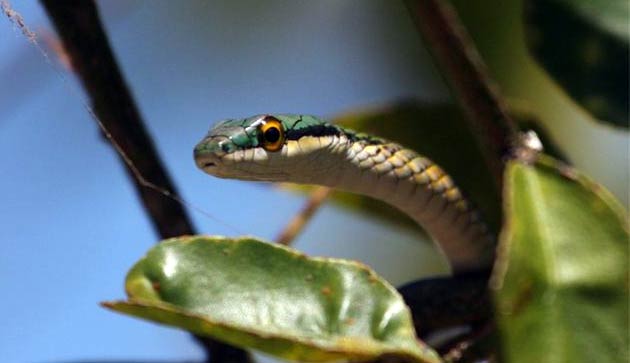
Focus on Reptiles
Thursday, November 22, 2012
Our page on reptiles -Reptiles of Ibera -may be of interest to some of you. We hope to be adding more photos to this page in due course.
We have had a lot of luck with reptiles which Gomez our ranger seems to regularly find. We have dozens of Caimans in the south and were delighted to see a Broad-snouted Cayman there in January. Re snakes: so far we have seen and photographed a Parrot Snake (see left), a Yellow Anaconda, a Leopard Keelback, a Keeled sepia snake, several Bothyrops alternatus (very venomous), a Coral Snake (venomous) and two False Water Cobras. We came across another Yellow Anaconda in early June in a hole in the ground and also a juv in a hole in August.
This page also features a large lizard known as the Black Tegu and a small Skink, the Lined Skink.
Jabiru nest with 2 young
Sunday, November 18, 2012
Maned Wolf seen at Don Luis
Monday, November 5, 2012
More news from Reserva Don Luis. Last week we had 150mm of rain which was desperately needed. Now everything looks green, the ponds have filled and some of our miriad of water loving creatures have returned, such as our herons.
A Maned Wolf was spotted a few days ago at dawn by our ranger who was out on horseback. These shy creatures are very difficult to see so we are delighted that finally we have seen one with our own eyes as well as having seen images on camera trap, footprints and droppings, and having heard them calling.
We will be going out to Argentina on 14 November.

Maned Wolf on Camera Trap
Thursday, September 27, 2012
Last week finally we had an image of a Maned Wolf on one of our camera traps. We knew that these animals were in the area as we had seen many footprints around the reserve and have heard them calling at night, but this is irrefutable proof. The picture is poor as is usual for the night pictures on these remote cameras but you can see it has caught a small mammal (probably a Cuis).
We have spent a wonderful 3 weeks at the reserve with a variety of weather including temperatures of 35 degrees and yesterday morning only 6 degrees C. We are still in drought unfortunately but everything is looking green in early spring and we had 35mm of rain in total during our stay.
The Jabirus are nest building and it looks like the endangered Ochre-breasted Pipits are breeding. There are many more Cuis around the reserve as a result of the dry weather but very few Herons unfortunately.
There are several new photos in the bird gallery and we will be adding photos to the home page and Reserve page.
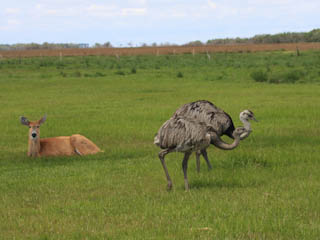
Giant Rheas make their home at reserve
Friday, September 14, 2012
We have spent a week at the reserve and are pleased to note that the Giant Rheas appear to have made their home with us.
Noteworthy items are the presence of Ochre-breasted Pipits which seem to prefer the grass which has recently been burnt. No sign of Strange-tailed Tyrants or the endangered Sporophila species as they prefer taller pasture. Unfortunately this will take almost a year to re-grow.
We have visited a wildlife rehab centre in the province of Missiones and there may be possibilities to re-home one or two of their animals. They have 5 beautiful Jaguars which live in very small cages at the moment although they are creating a better living area for these magnificent cats. We would love to have these at the reserve but they are not suitable for re-release.
We went on horseback to the southwest yesterday and saw many Maned Wolf footprints. Regretfully there is nothing yet on camera trap but we keep trying. We have heard the barking of this species several times at night and believe that they are calling for a mate.
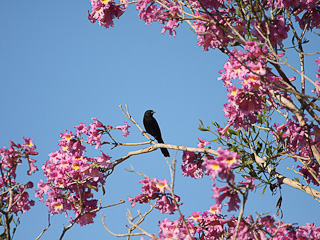
September in Don Luis
Tuesday, September 4, 2012
We arrived today (Tues) in Buenos Aires to a rather damp grey day and will be travelling by overnight bus to the reserve tomorrow.
September is a great time to see the wildlife as the birds will be starting to breed, the lapachos will be in full flower and with the rain we have had, everything should look green. The temperatures at the reserve this week have been in the 300s C already although I hope for more temperate conditions during my month's stay.
We are hoping to do some more research on bats this trip as well as looking for the Strange-tailed Tyrant, if there are any left after the fire. We are also in contact with a wildlife rehabilitation centre in Missiones which is not too far from the reserve. They have some rehabilitated animals that are looking for a safe place to be released so we may well see some Maned Wolves or small cats added to our inhabitants in the near future. We have also spoken to some neighbours who have many Giant Rheas and who would be happy to let us have a couple to add to the pair that seem to have adopted us.
We will be spending a couple of days at Rincon del Socorro to track and photograph the Giant Anteaters.
Internet is a problem at the reserve but I will try and post some photos when I can. More to follow........................
-2.jpg)
Rheas at the reserve! August 2012
Friday, August 10, 2012
We spent a wonderful 5 days at the reserve in early August.
The effects of the fire are severe, and the drought continues, but the grass is growing and we are seeing plenty of Marsh Deer. 2 Greater Rheas appear to have settled at the reserve - we are not sure from where they have come but are delighted to accomodate them.
We saw 2 Strange-tailed Tyrants whilst riding on 06 August which was a pleasant surprise, as well as a juvenile Yellow Anaconda. We managed to photograph a Red-winged Tinamou and a Buff-necked Ibis which we have added to the bird gallery. We also saw several Jabiru which is always a pleasure.
Our ranger is busy repairing the fences that were burnt in the fire and this will take several weeks as well as costing us a lot of money.
Through the use of satellite hotspots we have located the origin of the fire on 14 June but it will be almost impossible to reclaim any of our costs. However we shall certainly speak to the perpetrator.
Other exciting news is that finally I have seen the fawn of our tame Marsh Deer, 'Rosita'. It appears to be about 4-5 months old and is not in the least bit tame like his mother, which is a good thing. I was beginning to doubt the existence of this illusive creature!
Finally we are almost sure that we have a Maned Wolf at the reserve. We have placed 4 camera traps near to the area in which we have seen appropriate footprints.
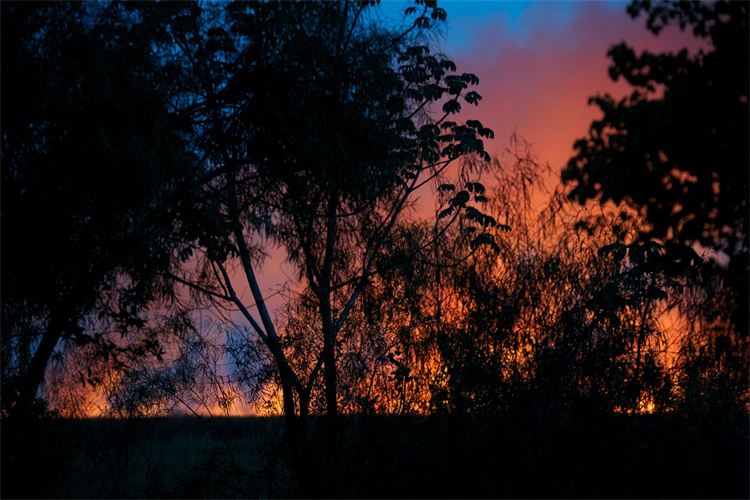
Fire Sweeps the Reserve
Saturday, June 16, 2012
We had bad news recently (15 June) from the reserve. It has been engulfed in a huge fire which has burnt all the area we had set aside for the Strange-tailed Tyrant. A lot of our fencing has been burnt as well as our horse corral. Our people there did a fantastic job in keeping the fire away from the houses and I understand that neither they nor the solar system are damaged. Thankfully no one was injured, the horses are all fine as is Rosita, our tame Marsh Deer. Gomez, our ranger, bravely set off on horseback to collect our camera traps just before the fire struck Don Luis so hopefully they are still serviceable. In the severe drought situation we are currently in, this is the worst possible scenario for our wildlife.
Many thanks to Gomez, Juan, Antonio, Daniel, the Guardeparques, Raul Motta and his team and the fire service which had to come a long way from Ituzaingo down 32km of soft sand road.
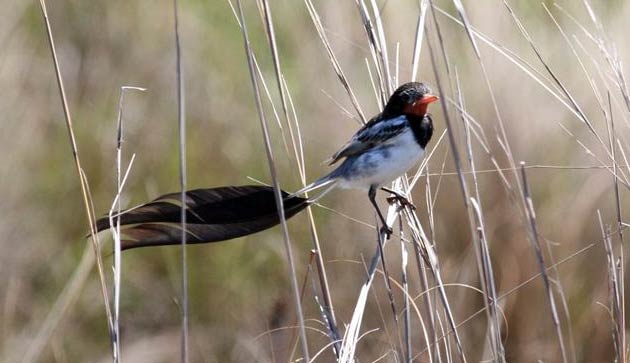
More Strange-Tailed Tyrants
Sunday, June 10, 2012
We spent eight days at the reserve (late May, early June) and were fortunate to see two Strange-tailed Tyrants - juvenile male and female - which could have been the two we saw in March with short tails. If so, evidently their tails have grown considerably in 2 months! We also looked for Rosita's fawn without success although we saw plenty of Rosita (our semi -tame Marsh Deer). In retrospect, we barely saw Rosita in March when the fawn was probably born and now it is a bit older presumably she is able to leave it for several hours at a time. I wish I could see it though!
The drought continues, unfortunately, with only about 250mm of rain recorded this year which is very little for this area. Fortunately in winter evaporation is less so the water is at least remaining at the same levels.
We suspect that there is a Maned Wolf at the reserve, quite close to the houses as we have seen gigantic mounds of poo which resembles fox poo but is a lot bigger. Also we have seen large footprints which resemble those of the Maned Wolf. We have set up an infra-red camera in this area.

Iguazu Falls
Sunday, April 8, 2012
We spent 2 days at Iguazu Falls in late March and have created a new page of the birds from there, some of which are distinctly different from the birds in our area even though we are only 380km apart. We have included a couple of mammals from Iguazu and have named this page Fauna of Iguazu Falls. We also had another session at the reserve 'Virocay' which has an amazing collection of birds including the Yapu, Streamer-tailed Tyrant and the Saffron-Cowled blackbird.
Photos will be added to our 'Fauna of Iguazu Falls' in due course.
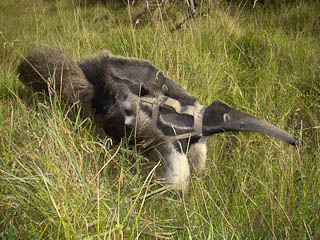
Capo Gets His Mobile!
Friday, March 16, 2012
The Giant Anteater project team have managed to fit a radio transmitter to the cub of Bomba, one the anteaters liberated into the reserve about 2 years ago. This will greatly assist the research into mother/cub relationships. This cub born in September 2011 has been named Capo and he has been fitted with a radio collar specially designed for a juvenile. You can see Capo by his right ear on the back on his mother in this photograph.
Three juvenile females have also been released into Rincon del Socorro - they are Emi, Olivia and Tusca.
At the end of the year Formosena was seen with a new cub - her second in a year. The project is progressing very well at the moment!
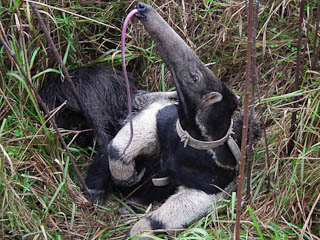
Good News November
Tuesday, November 29, 2011
Better news from the Giant Anteater project team in November. There have been 2 more births as well as two more reintroductions. This now makes a total of between 18 -20 specimens roaming the reserve of Rincon del Socorro.
Bomba, a female who has been in the reserve for about a year, was seen with a very young cub on her back in September. We are able to keep an eye on this development as Bomba wears a radio collar.
To our surprise, Tota has had another cub which makes two within a period of a year. Both the new cub and the previous one, which appears to be independent of its mother, appear to be in good health.
Finally, two male juveniles have been introduced to the reserve having spent some months in quaranteen. They are called Evaristo and Hoci.

